Our verdict
- Top pick in best walking shoes
- Top pick in best shoes for walking and standing all day
Pros
- Plenty of cushioning for long hours on feet
- Soft yet bouncy ride
- Feels nice and light on foot
- Abrasion-resistant upper and outsole
- Wide and steady platform
- Excellent outsole grip
- Easy on-and-off with bungee laces
- Upper made of recycled material
Cons
- Not very breathable
- Flimsy inner lining and insole
Audience verdict
- Top 27% in shoes for walking on concrete
- Top 12% most popular walking shoes
Comparison
The most similar walking shoes compared
+ + Add a shoe | |||||
|---|---|---|---|---|---|
| Audience score | 90 Great! | 91 Great! | 82 Decent! | 86 Good! | |
| Price | $160 | $110 | $140 | $130 | |
| Arch support | Neutral | Neutral | Neutral | Neutral | |
| Shock absorption | High | High | Moderate | Moderate | |
| Energy return | High | High | Moderate | High | |
| Traction | High | Moderate | - | High | |
| Orthotic friendly | ✓ | ✓ | ✓ | ✓ | |
| Weight lab Weight brand | 9.4 oz / 266g | 10.8 oz / 306g 10.8 oz / 305g | 10.9 oz / 309g 10.9 oz / 309g | 8.4 oz / 237g 8.9 oz / 252g | |
| Lightweight | ✓ | ✗ | ✗ | ✓ | |
| Breathability | Warm | Moderate | Warm | Moderate | |
| Use | For standing all dayTravelCityDisneyEuropeFor nurses | CityDisneyEurope | For standing all dayCityDisneyEurope | - | |
| Size | True to size | True to size | True to size | Slightly small | |
| Midsole softness | Balanced | Soft | Balanced | Balanced | |
| Difference in midsole softness in cold | Normal | Small | Big | Small | |
| Insole thickness | Very thin | Thin | Average | Thin | |
| Removable insole | ✓ | ✓ | ✓ | ✓ | |
| Stiffness | Moderate | Moderate | Stiff | Moderate | |
| Torsional rigidity | Stiff | Stiff | Stiff | Moderate | |
| Heel counter stiffness | Flexible | Flexible | Moderate | Flexible | |
| Heel tab | None | None | Finger loop | Finger loop | |
| Drop lab | 8.7 mm | 9.3 mm | 8.0 mm | 8.7 mm | |
| Heel stack lab | 35.5 mm | 34.9 mm | 34.1 mm | 27.5 mm | |
| Forefoot | 26.8 mm | 25.6 mm | 26.1 mm | 18.8 mm | |
| Width / fit | Medium | Narrow | Narrow | Medium | |
| Toebox width | Medium | Medium | Narrow | Medium | |
| Closure | Bungee laces | Laces | Bungee laces | Slip-on | |
| Toebox durability | Good | Good | Good | Decent | |
| Heel padding durability | Bad | Decent | - | Decent | |
| Outsole durability | Good | Decent | - | Good | |
| Midsole width - forefoot | Wide | Average | Average | Average | |
| Midsole width - heel | Wide | Wide | Average | Average | |
| Outsole hardness | Average | Very hard | Average | Average | |
| Outsole thickness | Average | Average | Average | Average | |
| Tongue padding | Average | Thick | Average | Thin | |
| Tongue: gusset type | Both sides (semi) | Bootie | None | Sock like | |
| Material | Mesh | Mesh | - | Mesh | |
| Ranking | #16 Top 45% | #9 Top 25% | #34 Bottom 5% | #27 Bottom 25% | |
| Popularity | #4 Top 12% | #6 Top 17% | #5 Top 14% | #29 Bottom 19% |
Who should buy
We believe that the On Cloudtilt is a must to consider if you are after:
- a well-cushioned but light shoe for long hours of walking and standing
- a clean-looking shoe with icy/minty colorways to fuse comfort and style in urban settings
- a shoe that's quick to get on and off thanks to bungee laces
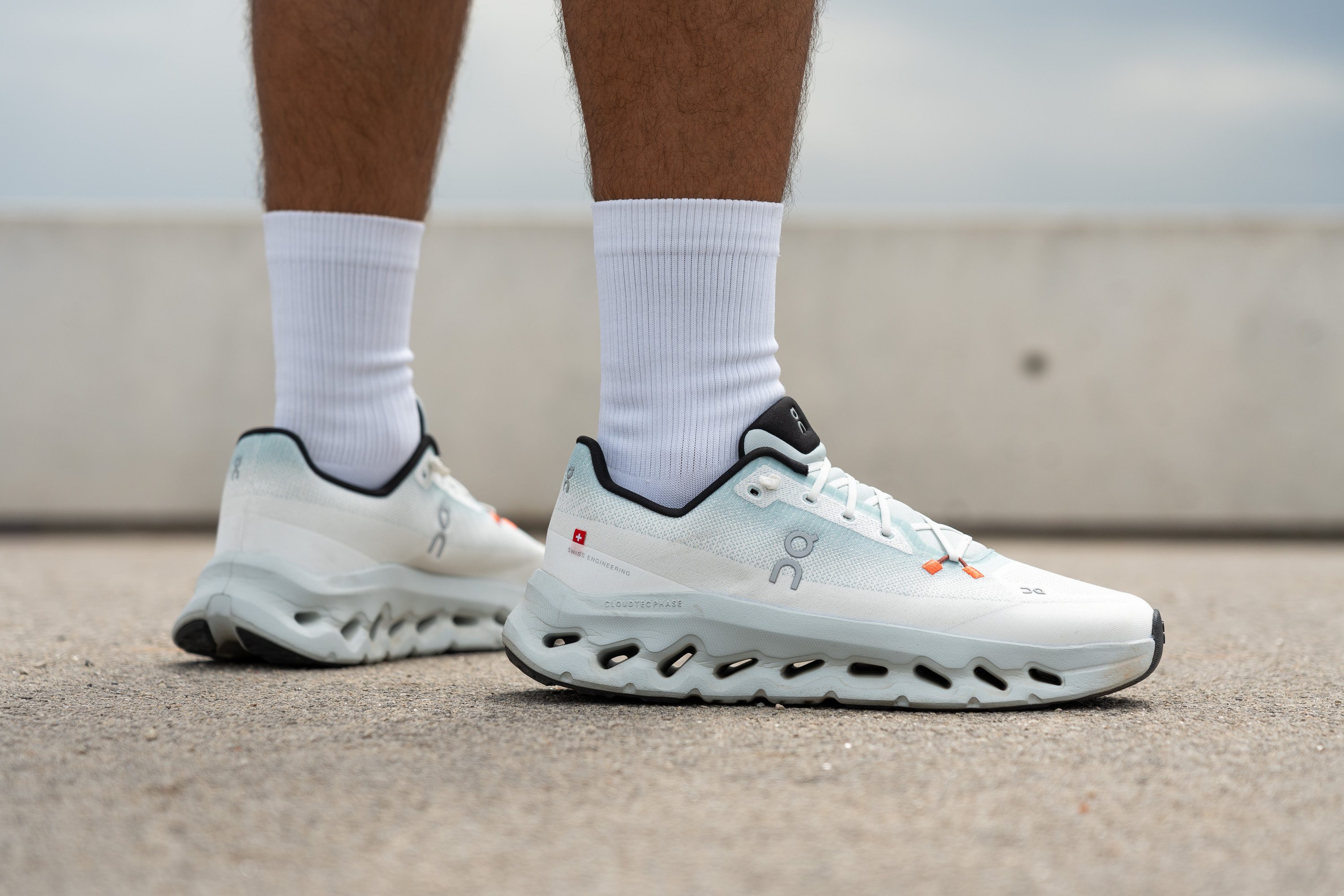
Who should NOT buy
The Cloudtilt's lack of breathability can be a real problem for people who need an airy summer shoe (for heatwaves and all). In this case, we strongly recommend thinner uppers of the Cloud 5 Push or the Cloudrift instead.
Another reason to look away from the Cloudtilt is if you need more toebox space (be it for wide feet, toe splay, or bunions). Some On shoes like the Cloudgo and the Cloudrunner 2 are available in wide options.

Cushioning
Shock absorption
With an exceptionally high shock absorption measurement of 132 SA, the Cloudtilt gave us all the cushioning and impact protection we needed to reach that daily 10K-step walking goal!
If you want a cushy walking shoe to take care of your feet and joints for hours on end and minimize fatigue at the end of the day, this On shoe is ideal for the job!
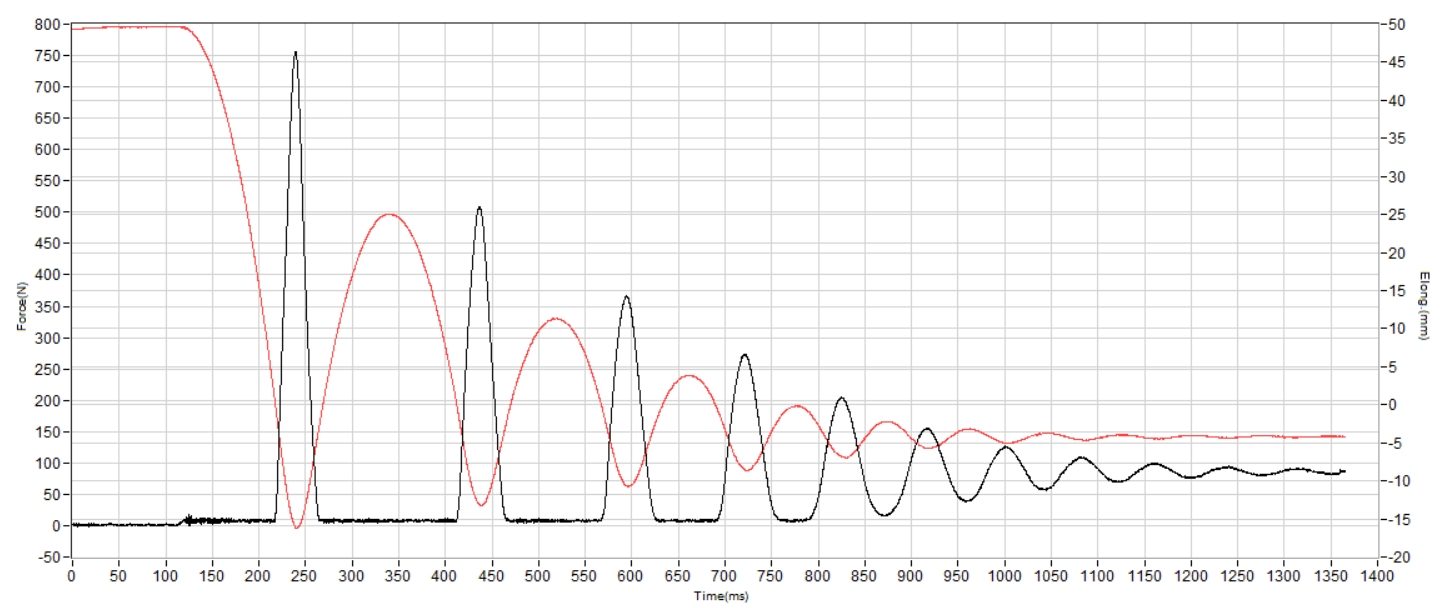
| Cloudtilt | 132 SA |
| Average | 111 SA |
Energy return
The Cloudtilt also feels amazingly lively and bouncy underfoot thanks to its above-average energy return of 58.1%. This adds propulsion to the shoe's ride and making it much easier to transition from one step to another.
| Cloudtilt | 58.1% |
| Average | 51.1% |
Heel stack
Putting the Cloudtilt on for the first time, we could feel its rather abundant cushioning. It is also a bit of a height booster with a heel stack of 35.5 mm!
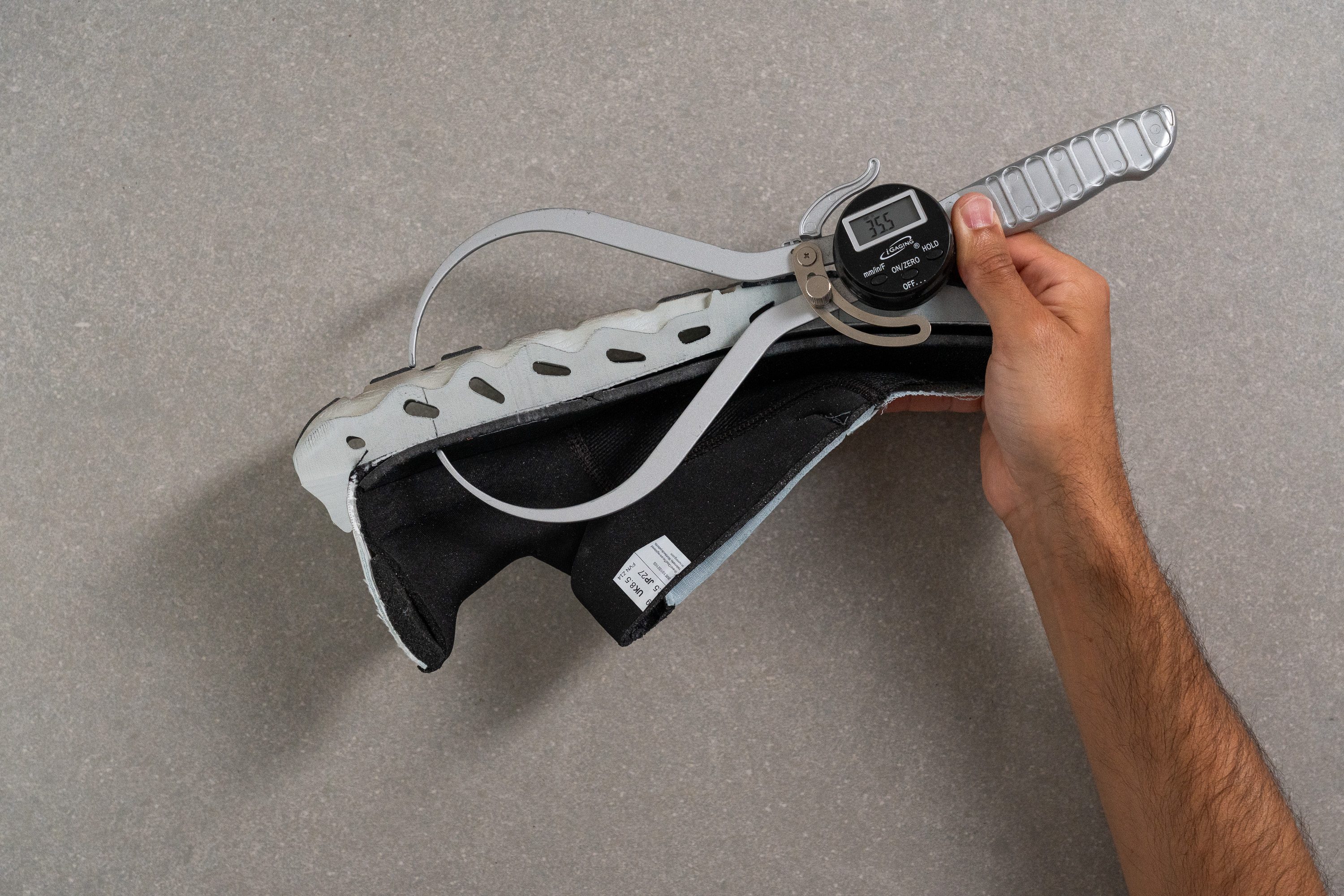
This caliper reading puts the Cloudtilt on the thicker end of On shoes. It is also a few millimeters thicker than the average of our lab-tested walking shoes.
| Cloudtilt | 35.5 mm |
| Average | 32.3 mm |
Forefoot stack
Quite expectedly, the forefoot stack of the Cloudtilt raises above most walking kicks as well. At 26.8 mm, it is a good 5 mm thicker than average!
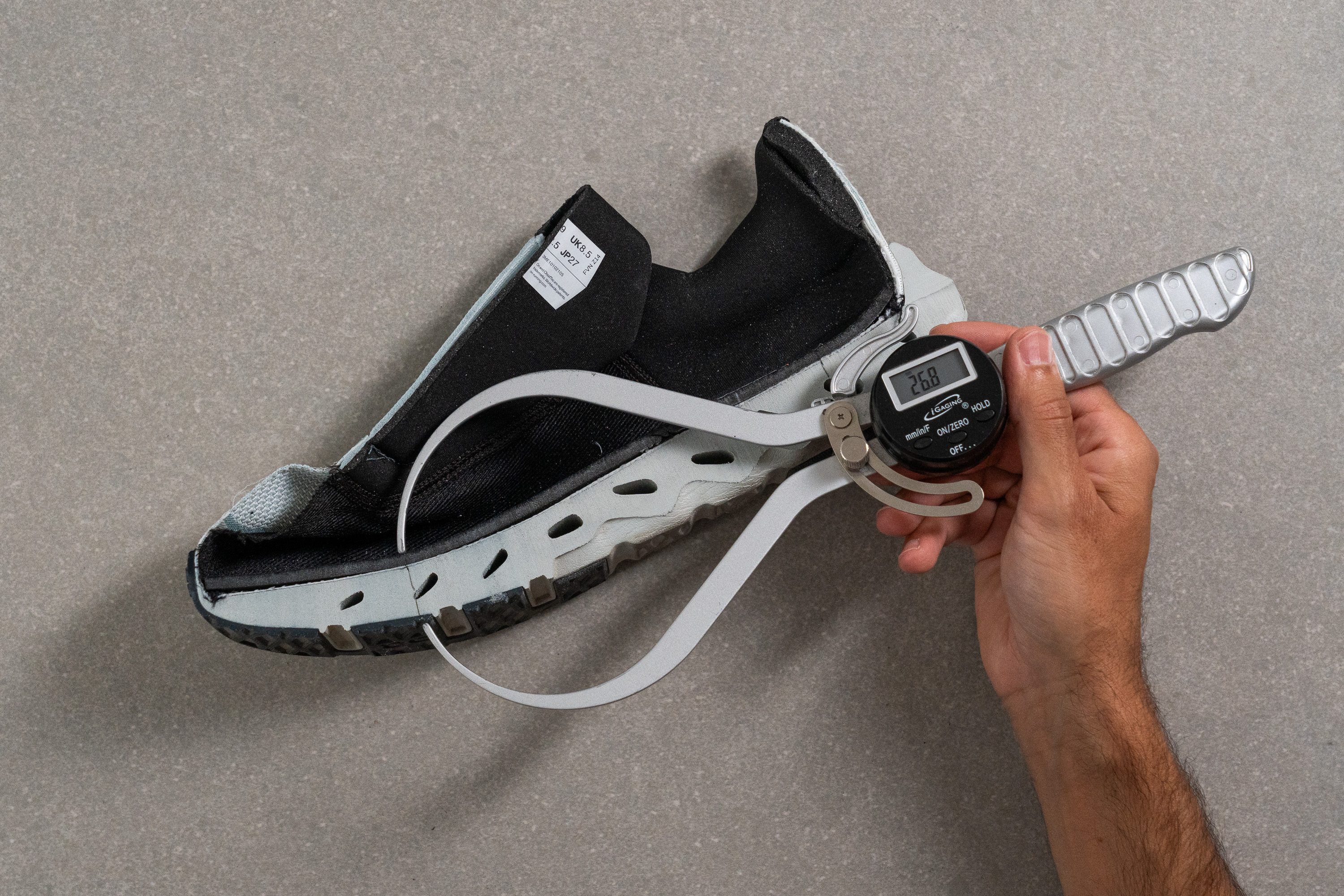
This solid helping of foam worked in tune with the shoe's rockered shape to give us some wonderfully smooth heel-to-toe transitions.
| Cloudtilt | 26.8 mm |
| Average | 21.9 mm |
Drop
According to On's official specs, the heel-to-toe drop of the Cloudtilt comes in at 7 mm. However, our own caliper showed a 1.7 mm deviation from that number.
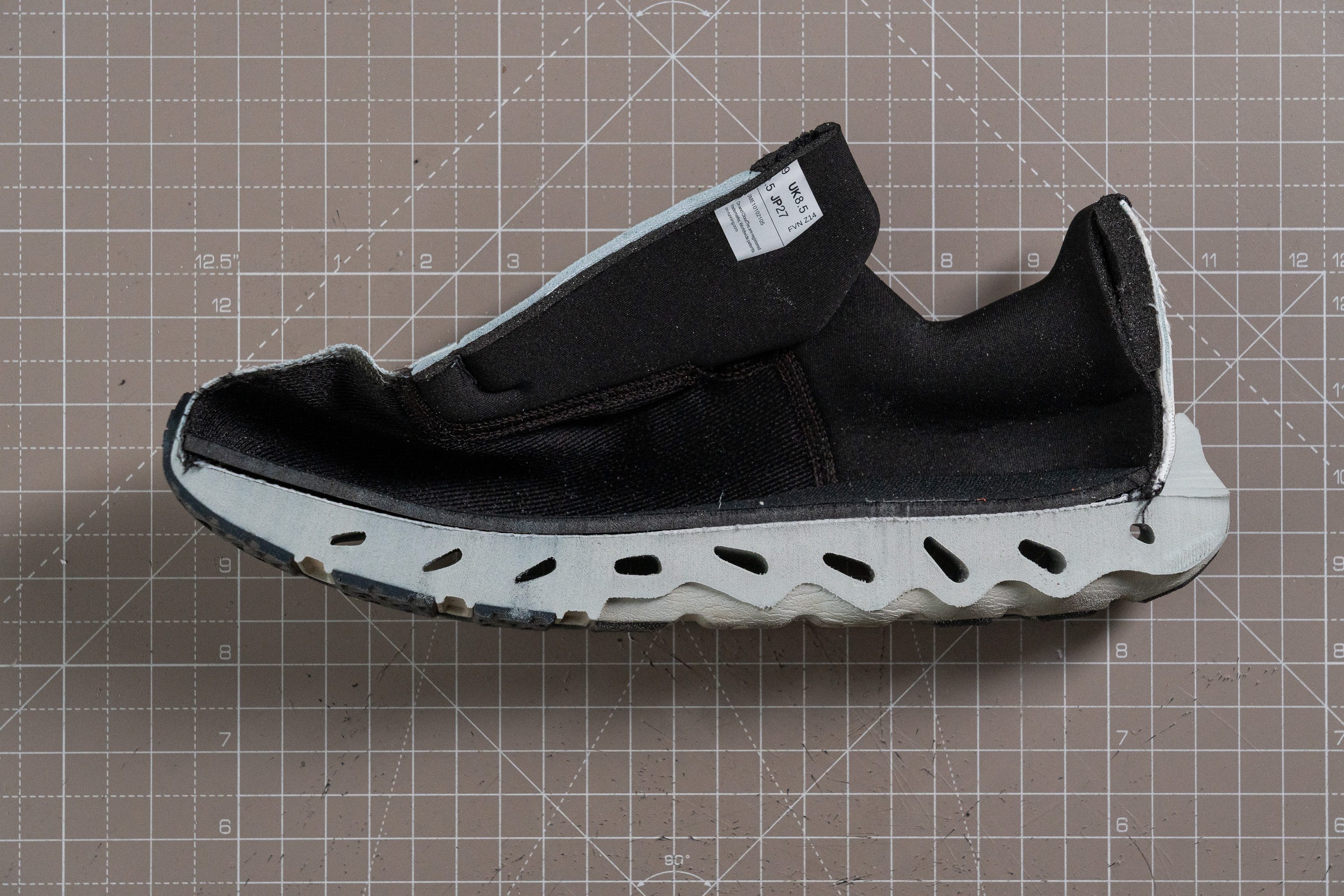
Based on our lab-measured stack heights, the difference between the shoe's heel and forefoot is slightly higher at 8.7 mm.
For most casual wearers, this doesn't change anything as the Cloudtilt still proved to be a well-cushioned companion with enough heel elevation to keep the rearfoot and the Achilles tendon supported. But we are obliged to point out all such inconsistencies, however minor.
| Cloudtilt | 8.7 mm |
| Average | 10.4 mm |
Midsole softness
Now let's dive into what makes the Cloudtilt's underfoot experience feel so good...Meet the Helion foam!

Showing a softer-than-average reading on our Shore A durometer (20.2 HA), this material indeed felt soft and responsive. But it's hard to talk about the Helion separately from the CloudTec Phase design in which it is incorporated.
The latter refers to the large cutouts in the shoe's midsole. We found that their compression elevates impact protection and comfort quite a bit! This is a great example of how smart engineering can turn less into more!
| Cloudtilt | 20.2 HA |
| Average | 26.4 HA |
Size and fit
Size
On Cloudtilt fits true to size (227 votes).
Width / Fit
The On Cloudtilt offered an expected fit for our medium-width feet. But to keep our assessment unbiased, we created a mold of the shoe's interiors using a proprietary gel to get the actual toebox dimensions.
Measuring the widest part of the mold with a caliper, we got a standard reading of 95.6 mm, just as we expected. Most people with medium-width feet will find it a well-fitting shoe for long hours of walking and standing.
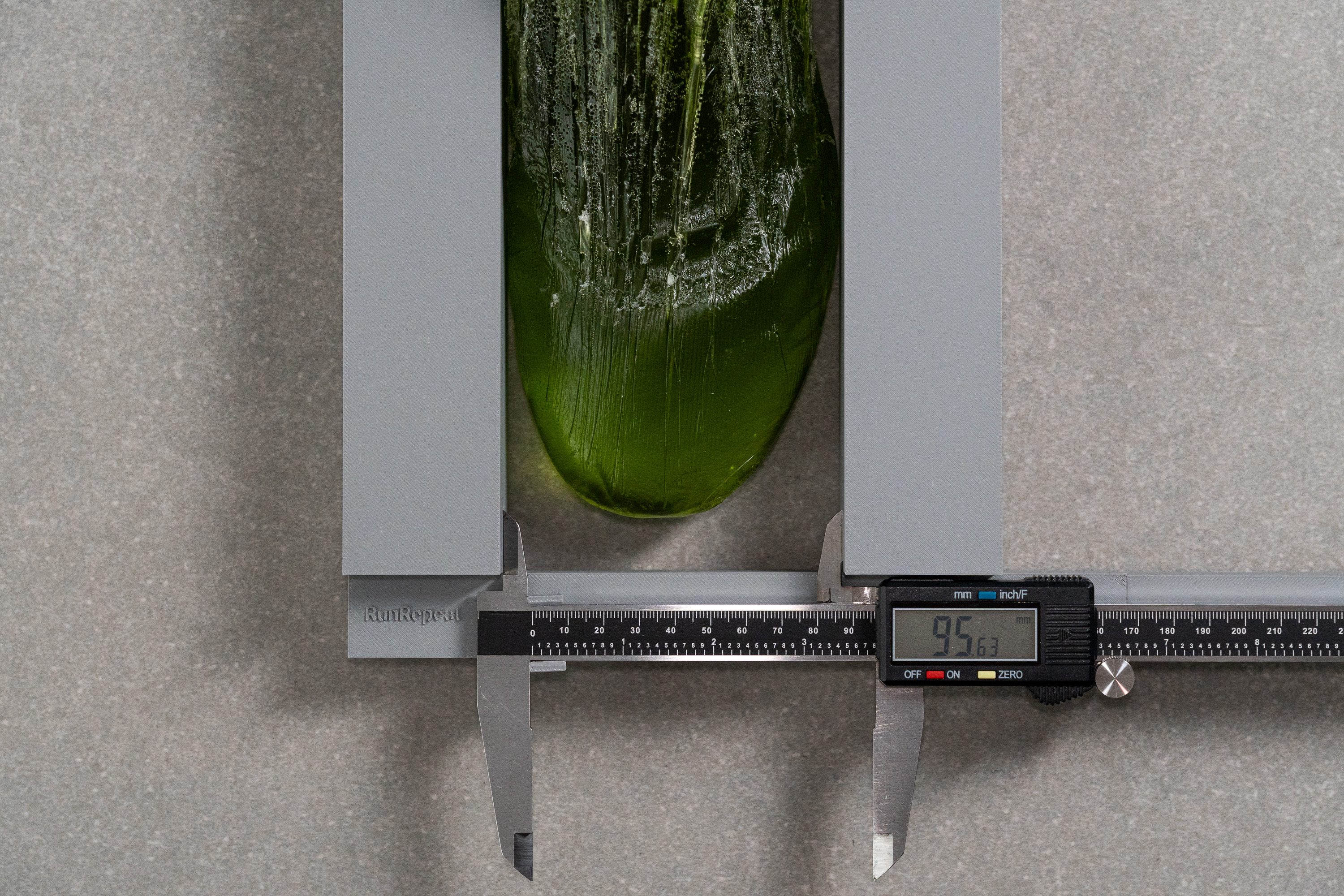
| Cloudtilt | 95.6 mm |
| Average | 94.4 mm |
Toebox width
The taper angle is also pretty mild in this On shoe, returning 71.6 mm of toebox width. It is on par with the average of walking shoes, providing a slightly rounded toebox shape to comfortably accommodate all toes.
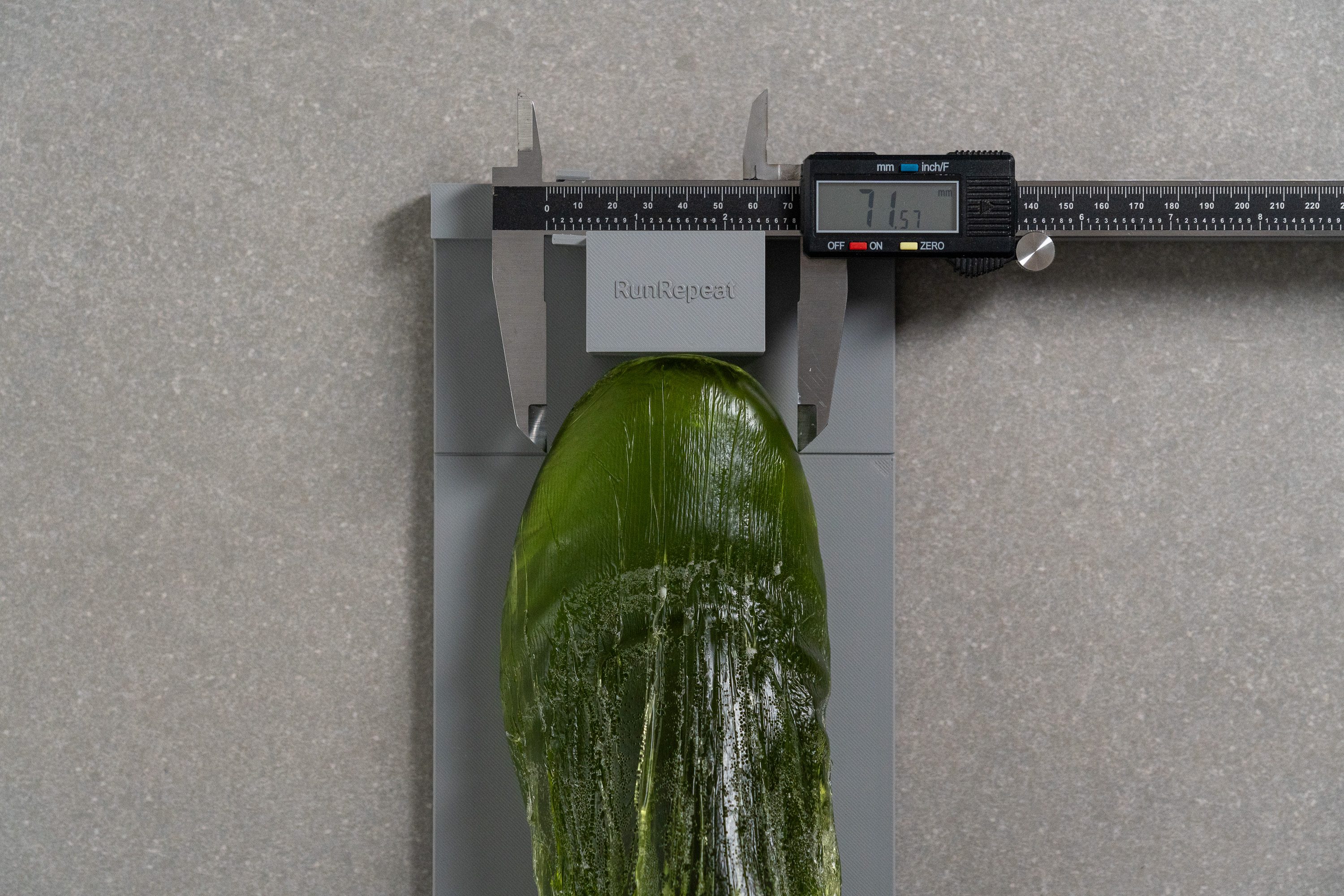
| Cloudtilt | 71.6 mm |
| Average | 71.2 mm |
Toebox height
The toebox height of the Cloudtilt brought no surprises either. Our caliper recorded a standard 26.6 mm of vertical space in the shoe's forefoot.
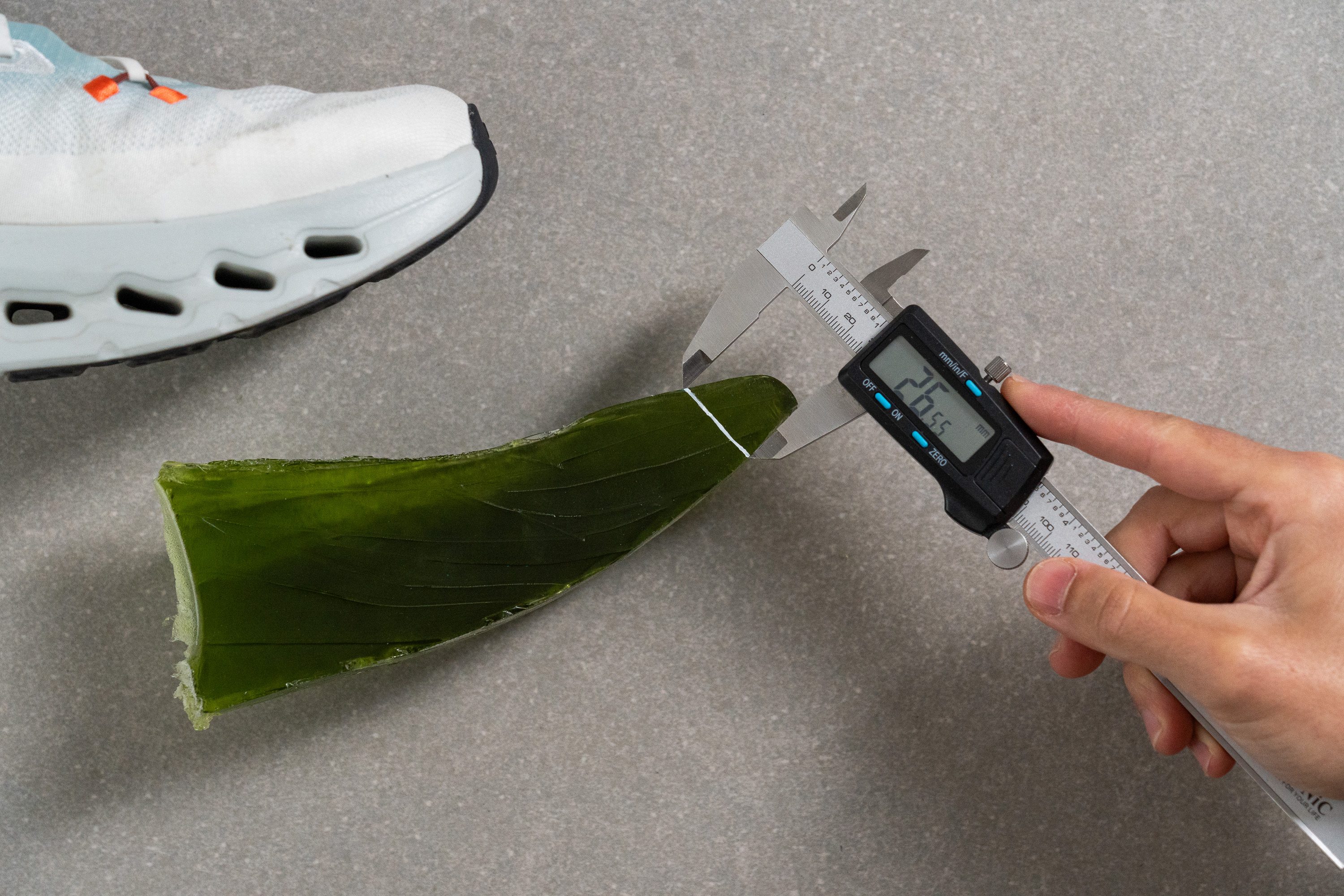
| Cloudtilt | 26.6 mm |
| Average | 26.4 mm |
Laces
The shoe's lockdown is complete with a speed lace setup, also known as bungee lacing.

This design eliminates the need for fiddling with laces and turns the Cloudtilt into a slip-on of sorts.
However, people with narrower feet or higher insteps may not bode well with this stretchy lacing. These folks will have to cut off and replace the stock laces.
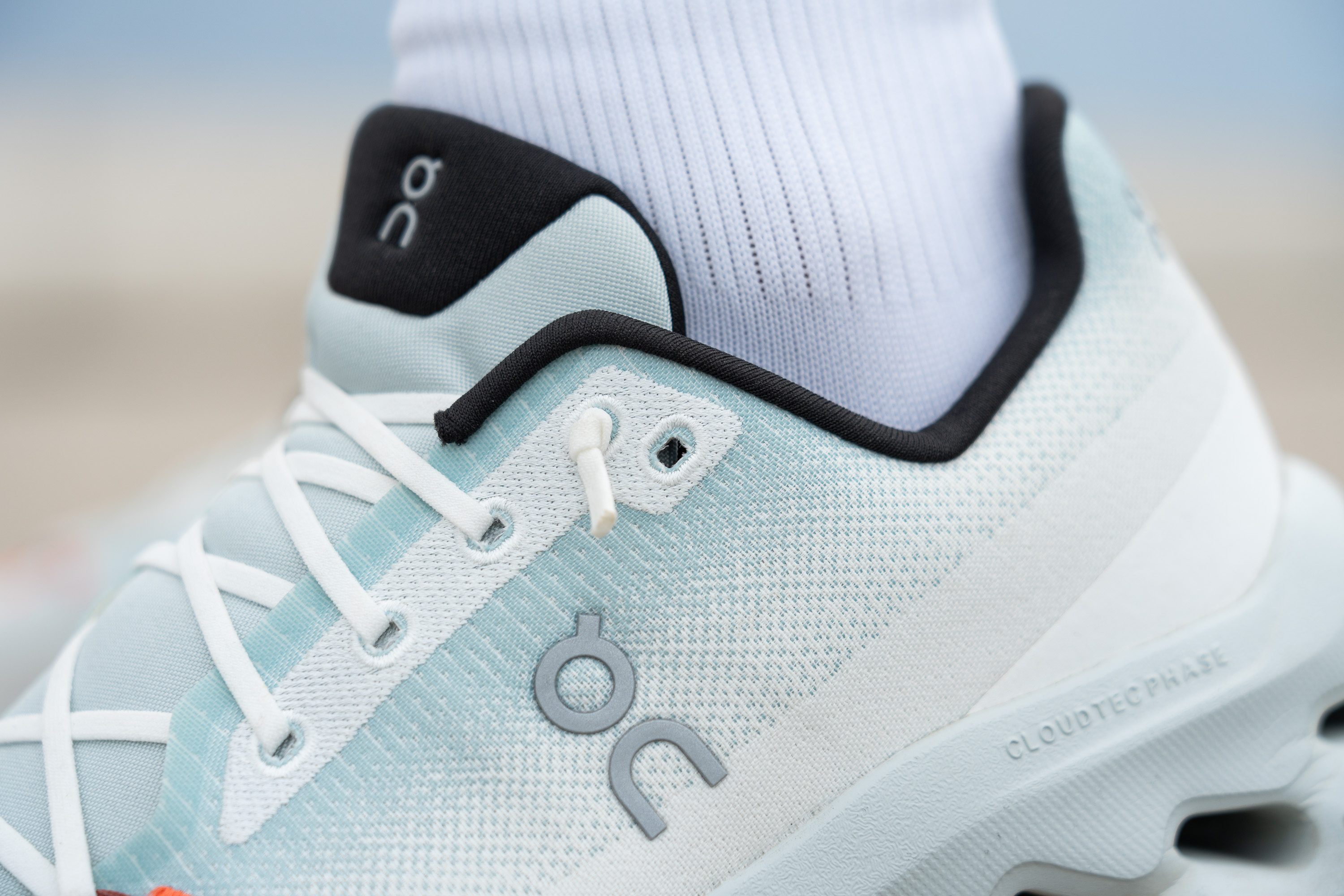
Making use of the extra eyelet may prove to be helpful as well.
Traction / Grip
Traction test
Lots of exposed foam and a huge gap running through the middle - does the Cloudtilt have the necessary grip to stay surefooted? We were relieved to discover that it does!
Following the SATRA TM144 grip testing method, we imitated a walking person's heel landing on a wet slab of concrete. The shoe returned a good coefficient of friction (0.47) proving the shoe's ability to resist the forward shear force and prevent the foot from slipping.
While it's not a 100% slip-resistant shoe, the Cloudtilt has a great grip on dry and wet urban surfaces like concrete and asphalt.
| Cloudtilt | 0.47 |
| Average | 0.46 |
Outsole design
The Cloudtilt feels more grounded than the other On shoes we tested mostly thanks to its wider and shallower pods which provide a broader contact area with the ground.
We also noticed that the shoe has more rubber coverage and it's a tougher and grippier type of rubber as well.
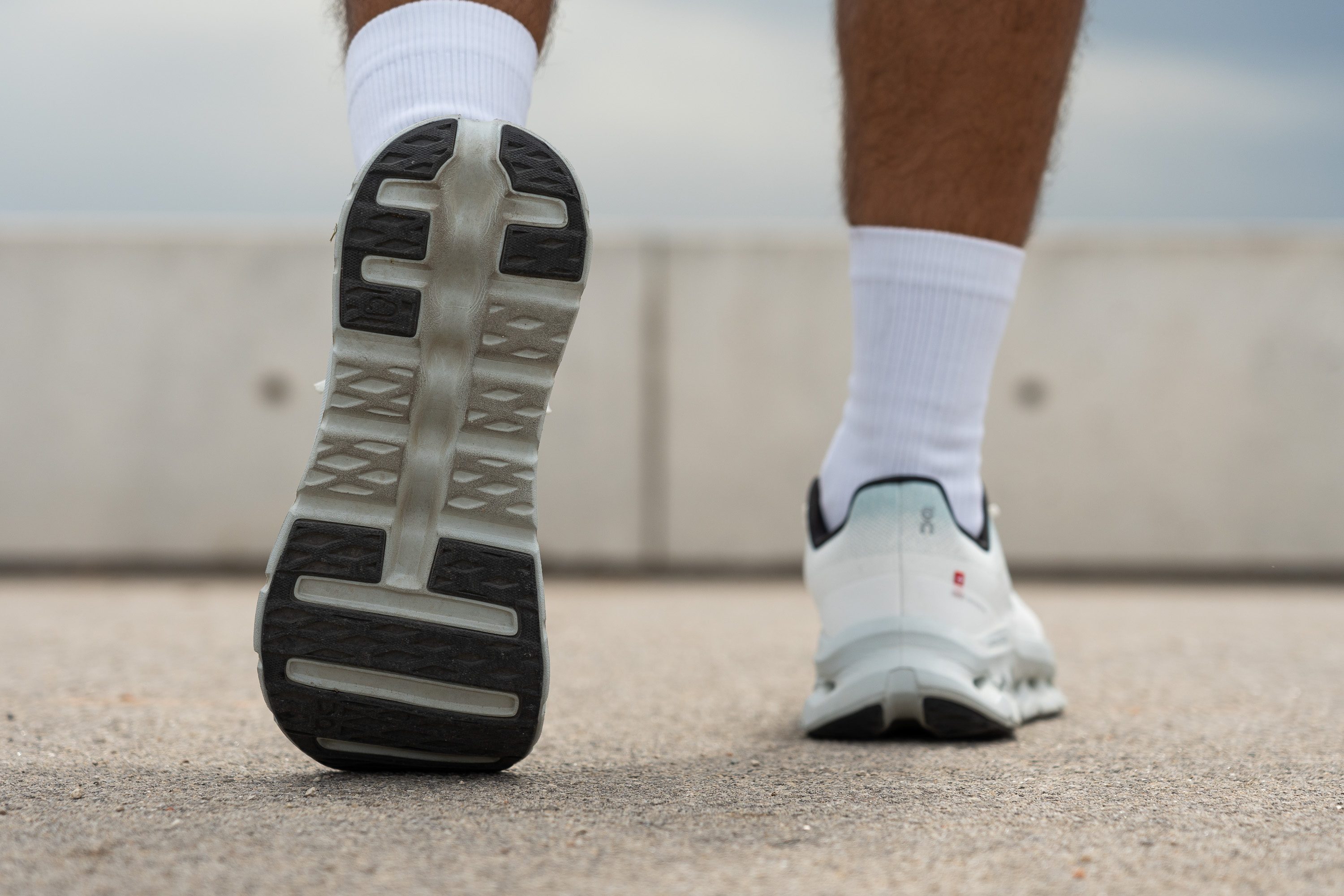
Flexibility / Stiffness
The shoe slightly exceeded the category average in our shoe flexing test requiring a force of 15.5N to bend by 30 degrees.
Its high-stacked midsole certainly contributed to that stiffness but overall we felt like the Cloudtilt still packed enough flexibility for a smooth and comfortable ride.
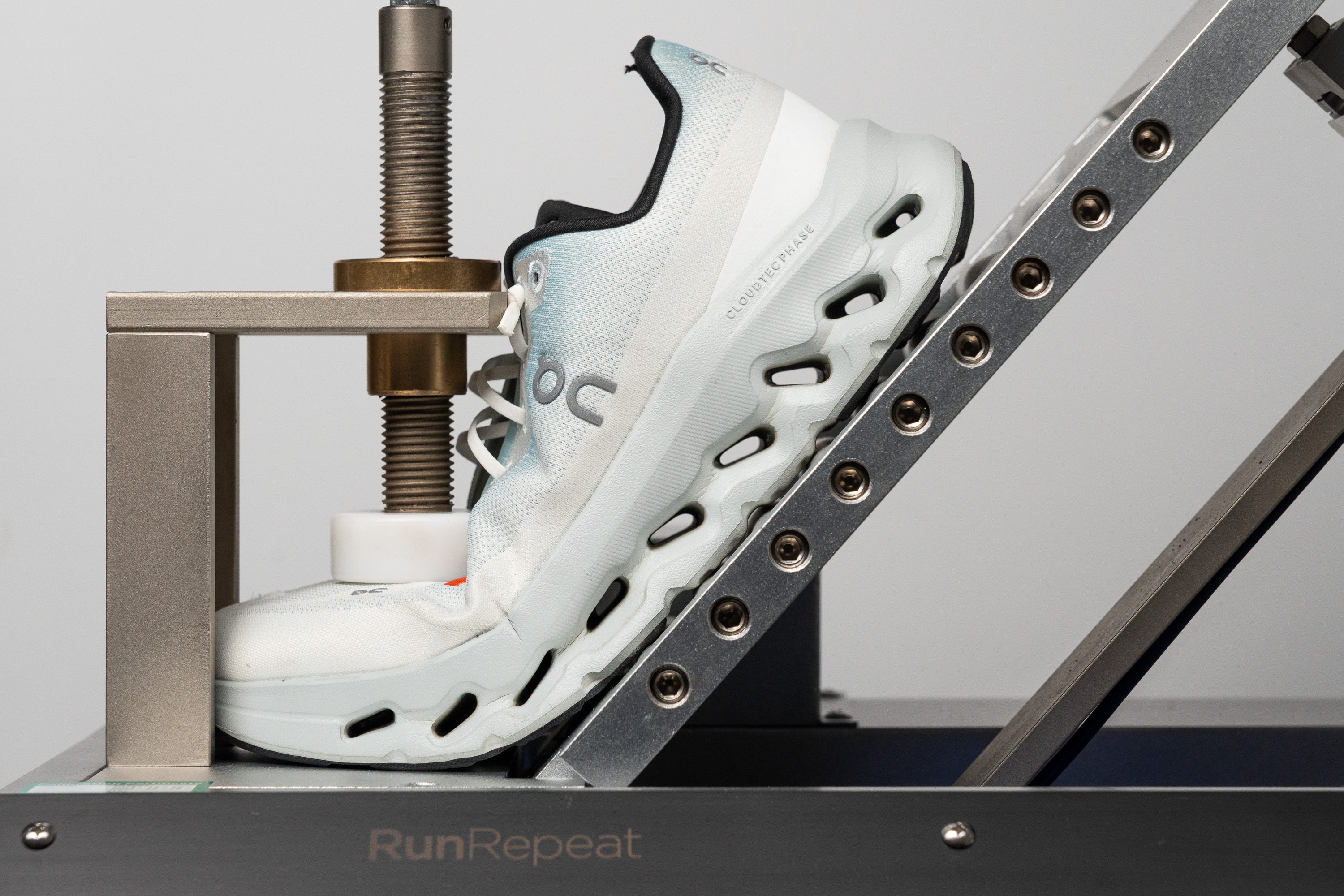
| Cloudtilt | 15.5N |
| Average | 13.9N |
Stiffness in cold (%)
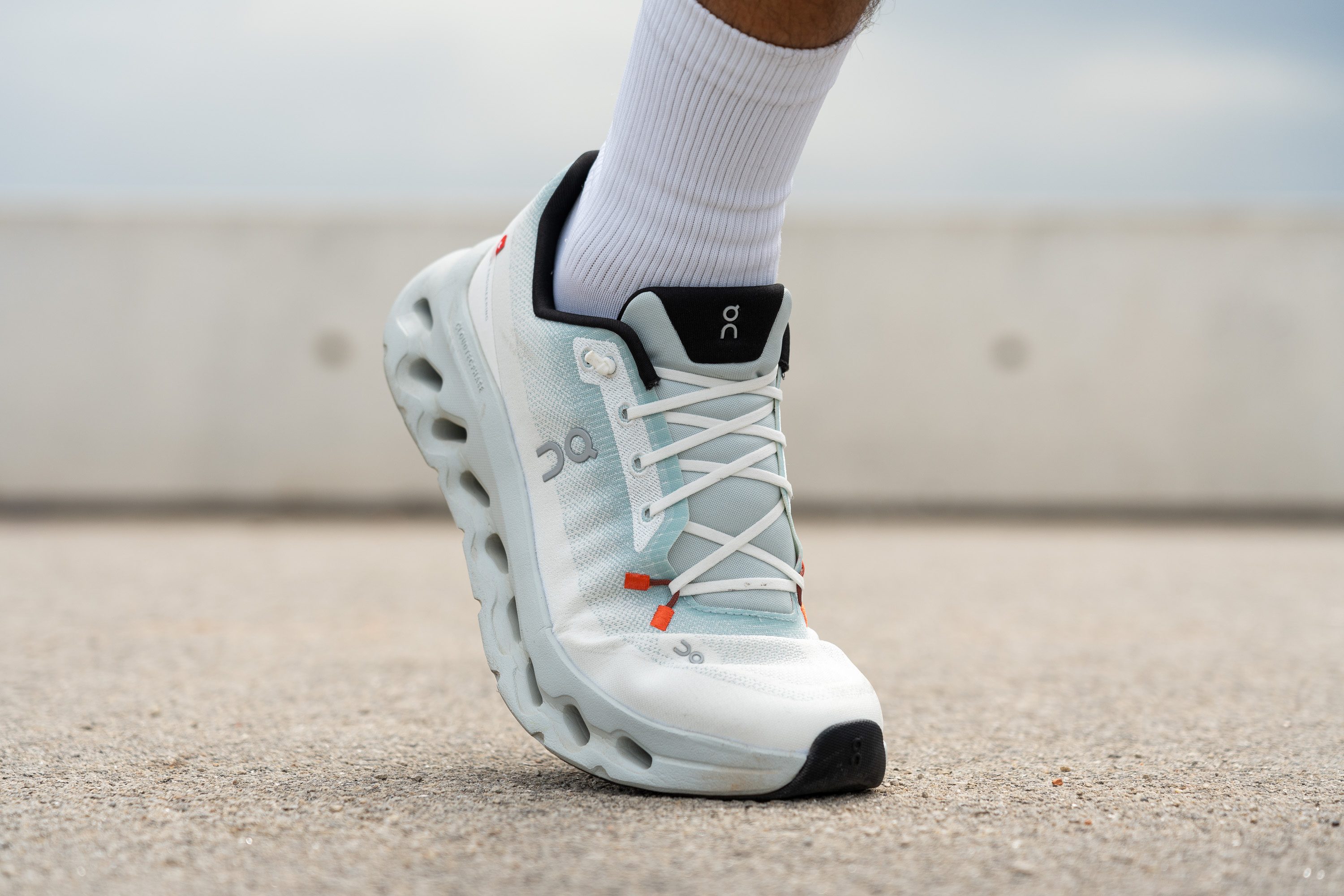
Weight
The Cloudtilt felt very nice and light on our feet and the scale reading confirmed it.
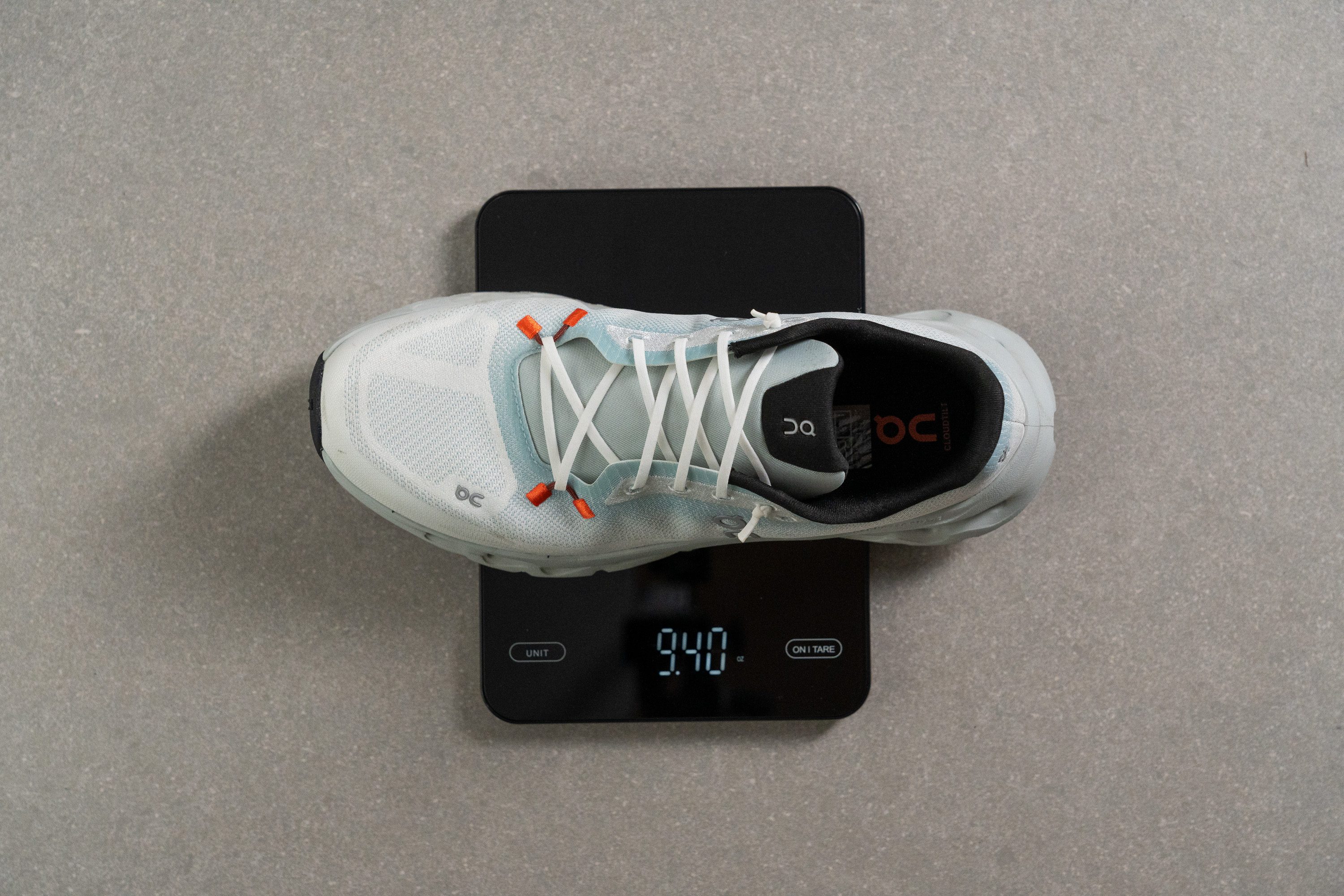
The shoe wasn't as weightless as some of the other On models we've tested (like the Cloud 5!) but its weight of 9.4 oz (266g) did clock in below the average for walking shoes.
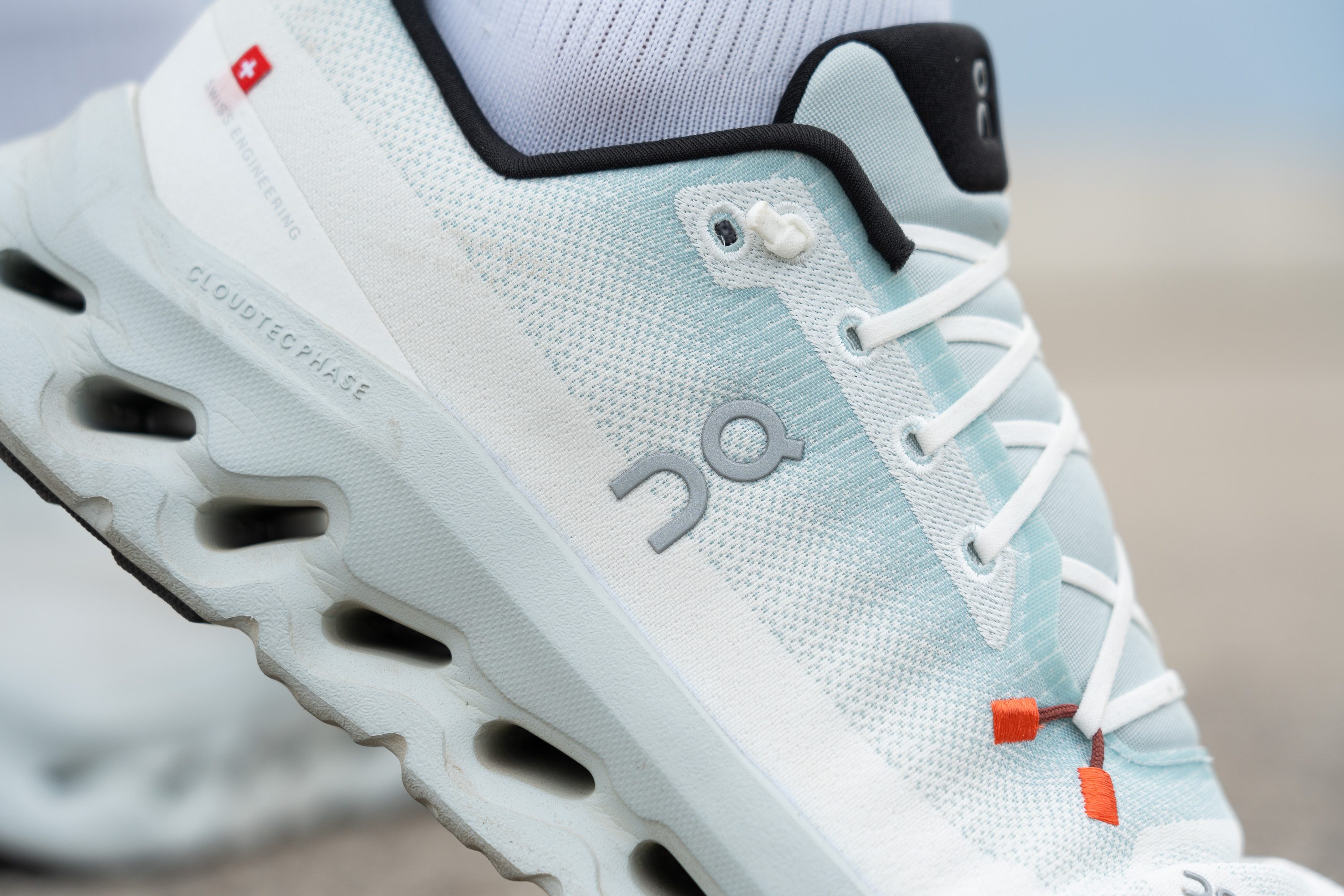
| Cloudtilt | 9.4 oz (266g) |
| Average | 10.2 oz (288g) |
Breathability
We are used to seeing ultra-thin and highly breathable uppers on walking shoes from On. However, the Cloudtilt changes this tendency with its notably thicker upper material. This, in turn, made the shoe less than ideal for hot weather.
Even though the shoe's toebox expelled smoke rather well, its ventilation level was lower than that of the On Cloud 5 Push and the On Cloudrift. These two shoes got the highest breathability score (5 out of 5) whereas the Cloudtilt earned only 2 out of 5.
Hovering the shoe's half-cut upper over the light, we didn't see a single transparent area. For comparison, this is how much light shines through the Cloud 5 Push.
We used a microscope to take an even closer look at the Cloudtilt's upper. Its fabric is so thoroughly engineered and tightly woven that we are not surprised that the shoe's airflow is so weak.
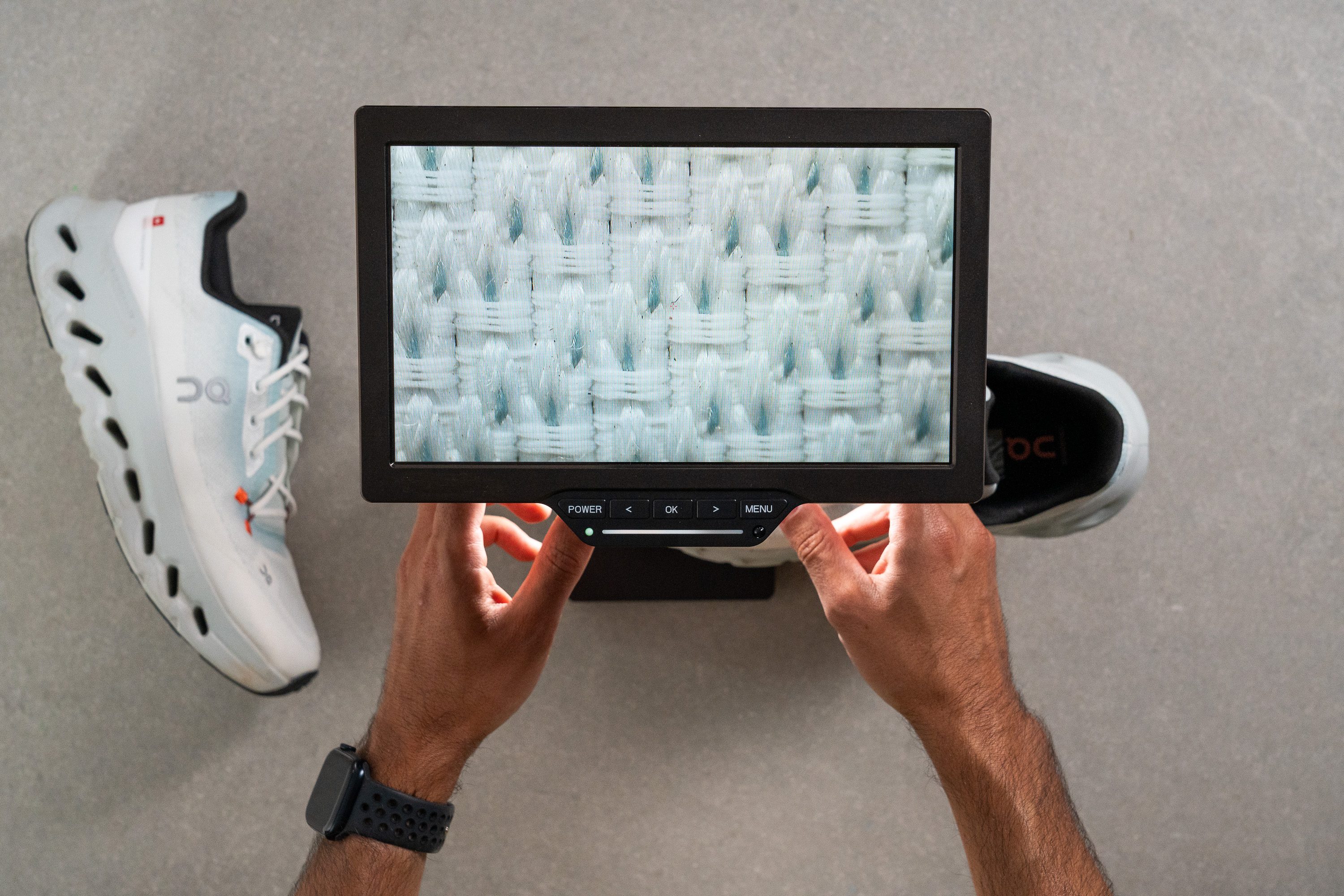
Just look at the striking difference in mesh porosity in the comparison photo of the Cloudtilt and the Cloud 5 Push.
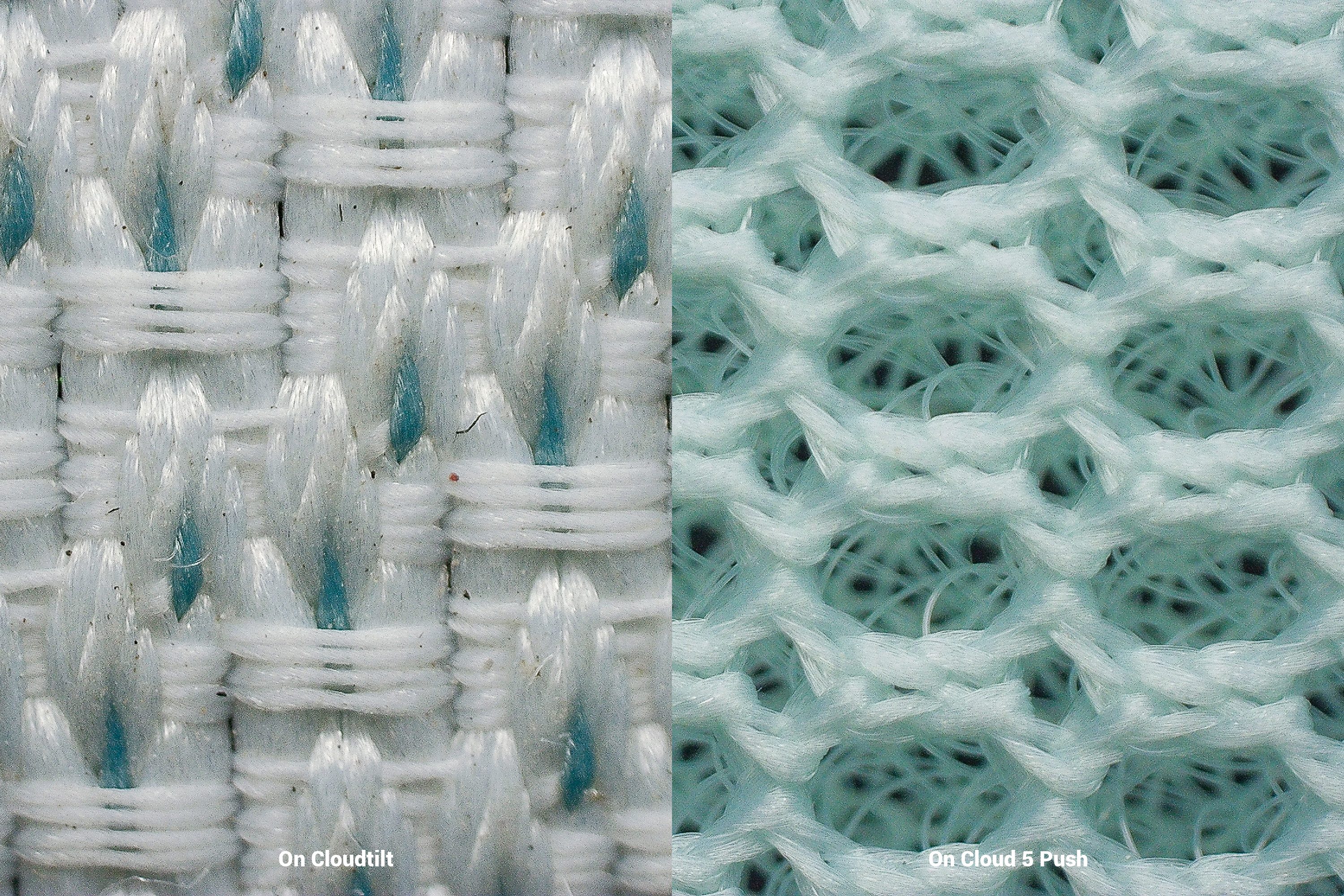
| Cloudtilt | 2 |
| Average | 2.9 |
Stability
Lateral stability test
With no mention of arch support in the Cloudtilt's official specs, we believe that it was made with neutral pronation in mind.
You can see from our lateral stability test below that our ankles have a good deal of freedom in this shoe. This could be a problem for someone with overpronation, or excessive inwards rolling of the foot. But for most people, this should not result in discomfort or ankle rolls.
If you do need a more supportive shoe, we recommend looking into the Cloudnova Form or other stability walking shoes in our catalog. These shoes are designed to keep the foot and ankle aligned to avoid uncontrolled pronation.
Torsional rigidity
If you are worried about feeling unstable due to the squishy pods, let us assure you that the Cloudtilt has a good amount of structure to keep you steady.
Twisting the shoe in our manual test, we discovered that it takes some good force to do that. On a 1-5 scale, where 5 is the stiffest, we rated the shoe's torsional rigidity as 4 out of 5. Pretty sturdy!
| Cloudtilt | 4 |
| Average | 2.9 |
Heel counter stiffness
However, the shoe's flexible heel counter makes it less suitable for people who need extra support.
Bending and flexing in every direction, the heel counter offered a very minimal amount of heel hold. Again, enough for neutral pronation but not so much for excessive inward rolling of the foot.
Giving it a stiffness score from 1 to 5, we chose 2.
| Cloudtilt | 2 |
| Average | 2.4 |
Midsole width - forefoot
Gladly, the Cloudtilt offers enough platform to land on and feel surefooted.
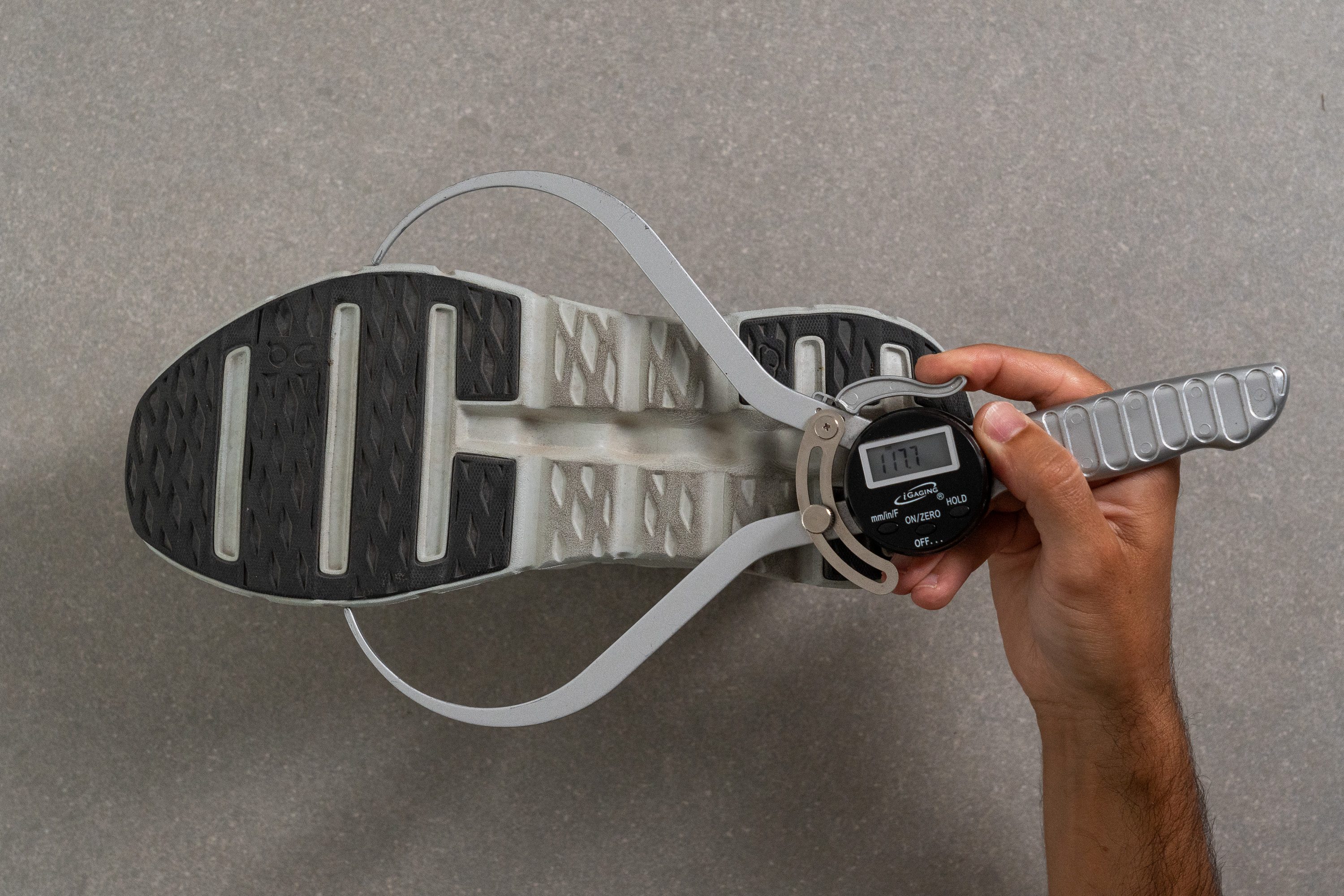
Putting our caliper to the widest part of the shoe's midsole, we recorded as much as 117.7 mm. This is about 6 mm wider than average! Having extended contact points like this is a big bonus to the shoe's stability.
| Cloudtilt | 117.7 mm |
| Average | 112.0 mm |
Midsole width - heel
In the widest part of the heel, the Cloudtilt also showed a greater-than-average reading of 96.7 mm.
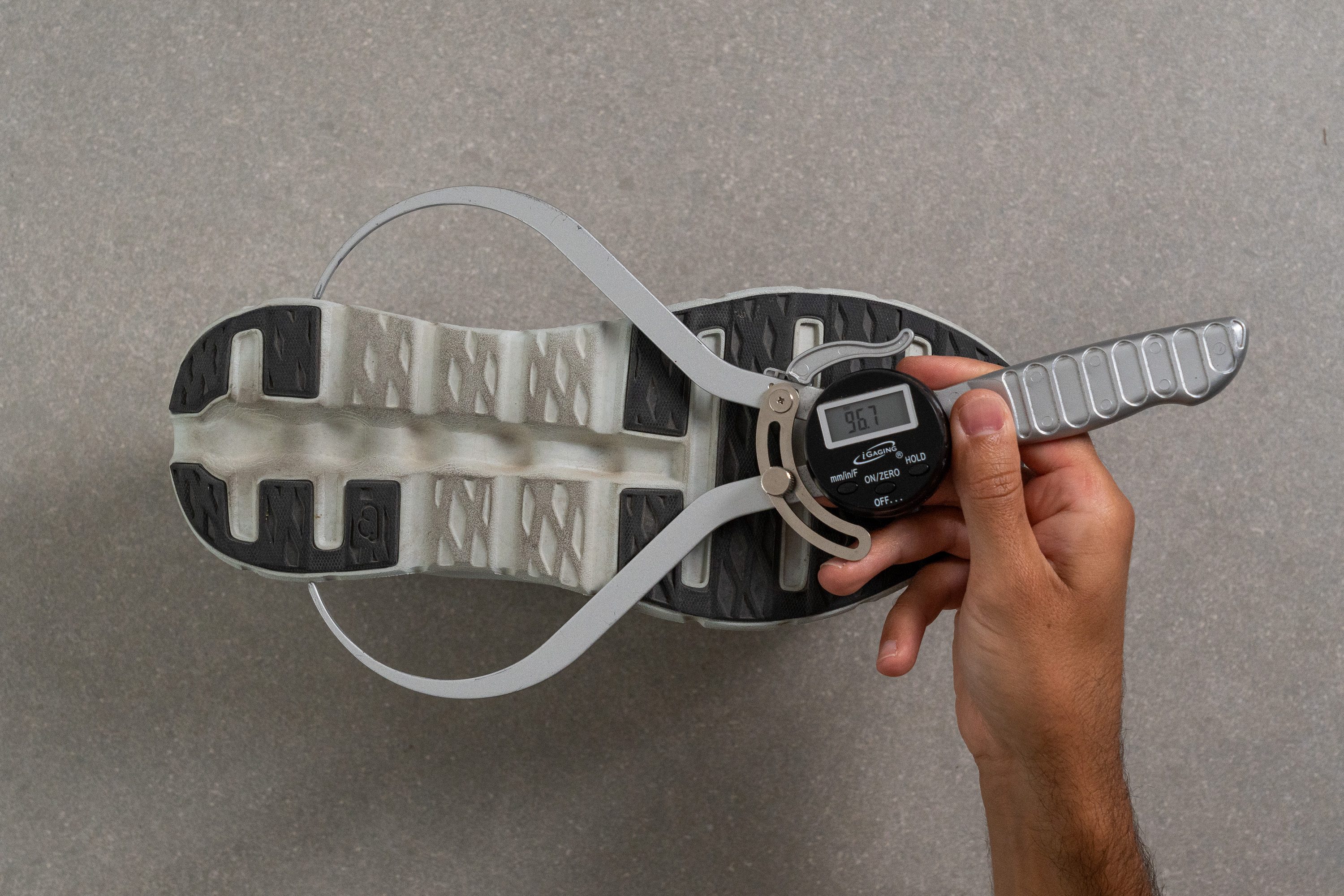
Along with the Cloudnova Form, the Cloudtilt turns out to have the widest platform among our lab-tested On walking shoes!
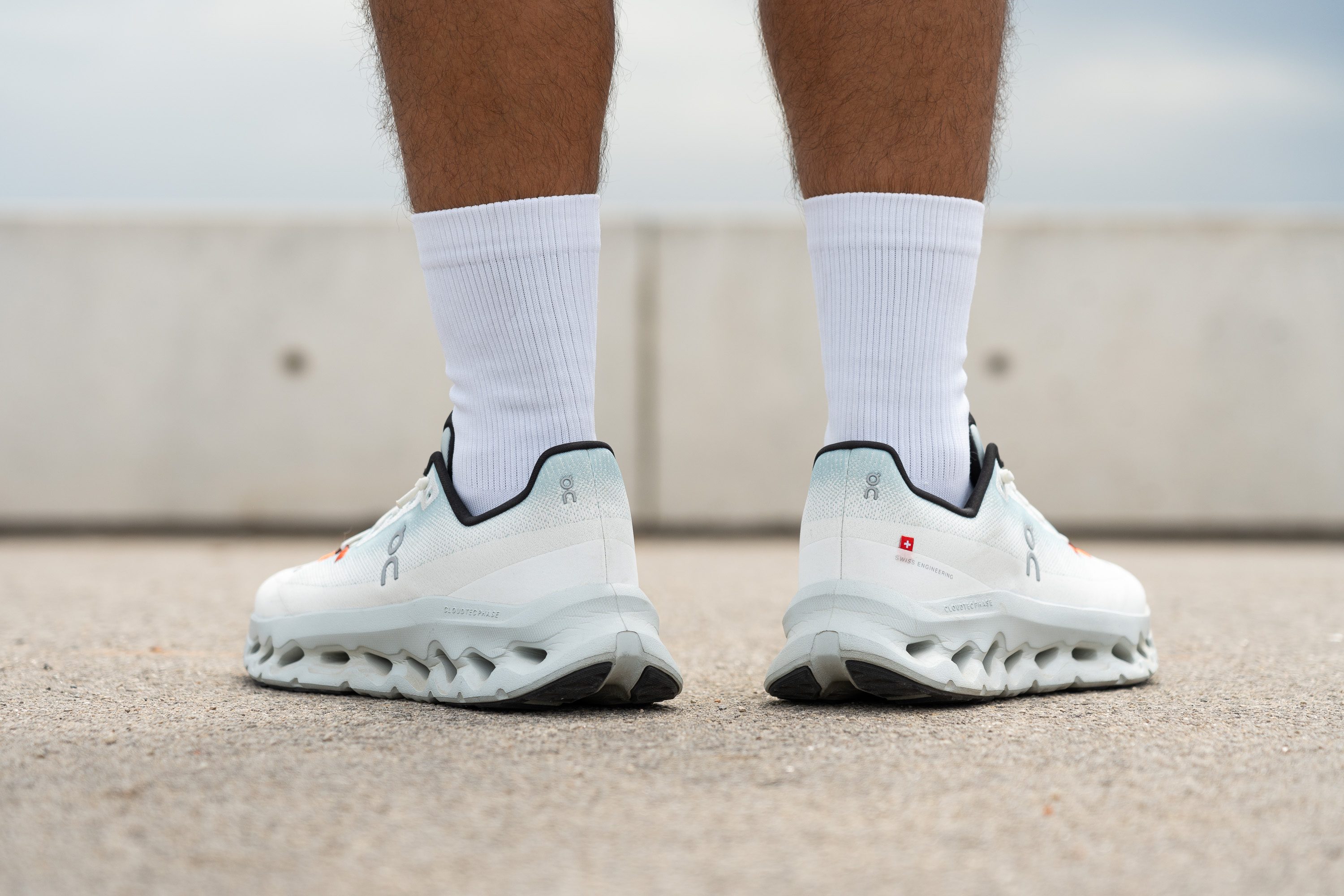
| Cloudtilt | 96.7 mm |
| Average | 90.3 mm |
Durability
Toebox durability
Just because it's made of recycled materials doesn't mean that the shoe is going to fall apart on your feet. The On brand proves this to be true with the Cloudtilt's recycled polyester upper.
We subjected the shoe's toebox to a demanding resistance test to check how it stacks up against other walking shoes in our lab. Using a Dremel, we drilled the same spot on top of the shoe's toebox at 5K RPM speed and 3.2N pressure for 12 seconds.
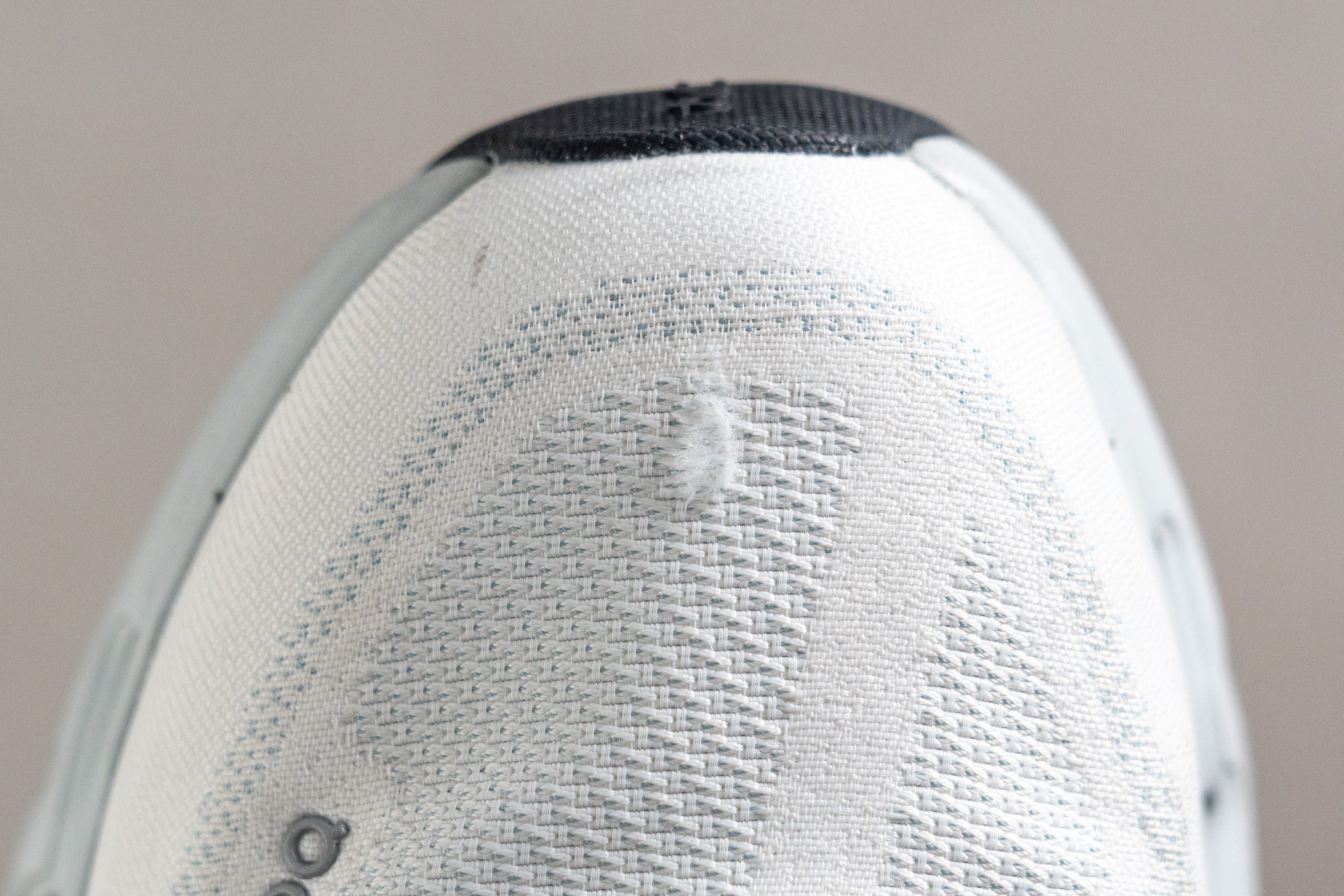
And that's where the thick and sturdy nature of the fabric paid off - the Dremel only fluffed up its topmost layer without tearing the material! We were excited to finally see a hard-wearing upper on a shoe from On! Why are we so surprised? Because we rated the Cloutilt's toebox durability as 4 out of 5 whereas the average of all previous On walking shoes sat at only 2 (with most scores being 1)!

Add to that a protective synthetic overlay all around the shoe's upper and you don't have to stop and check the integrity of your shoes each time you trip on concrete or slash your shoes against cobblestone.
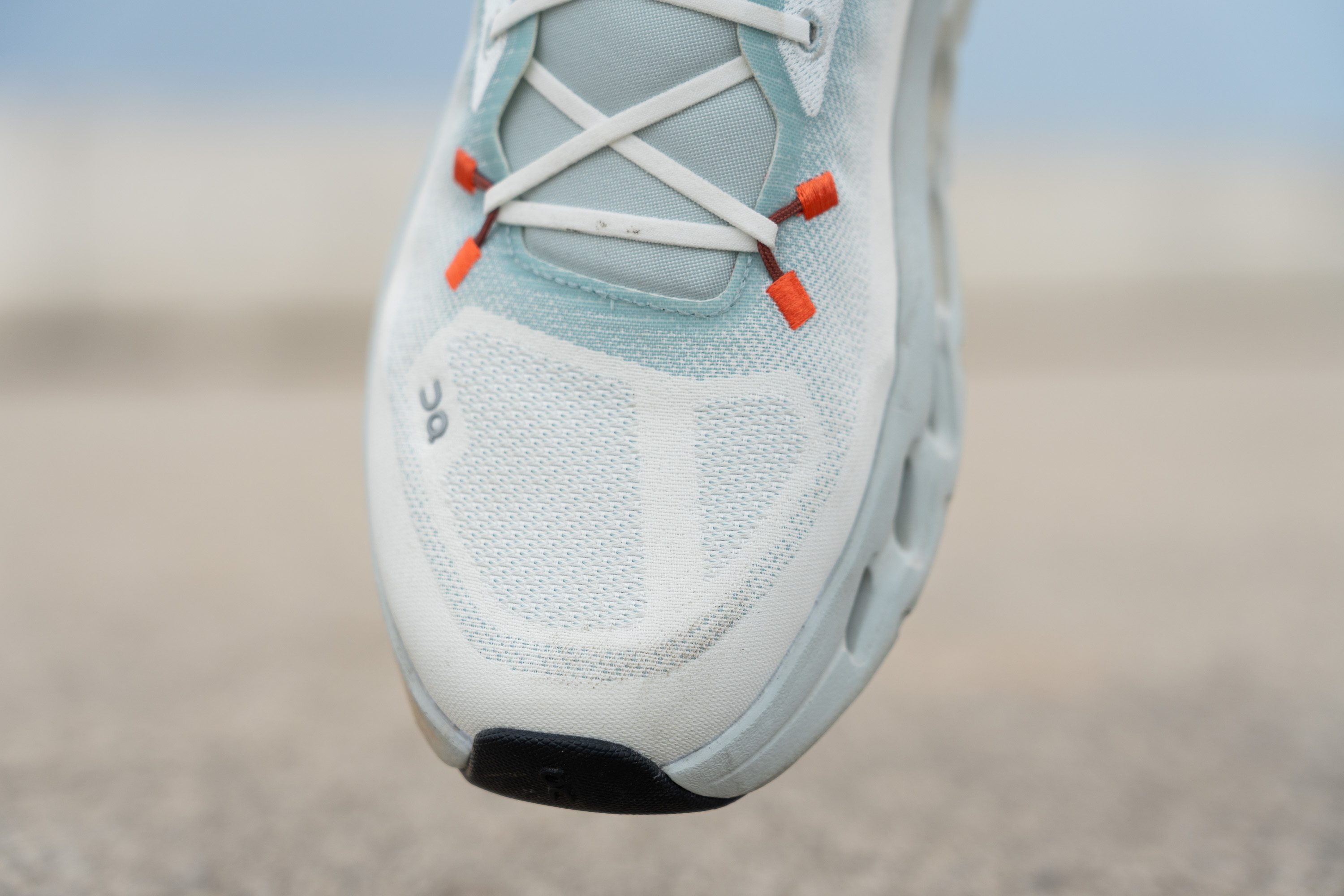
| Cloudtilt | 4 |
| Average | 3.2 |
Heel padding durability
Sadly, the fabric inside the Cloudtilt failed to meet our high-set expectations. Did On choose to save on the inner lining in favor of other shoe parts?
It took as little as 4 seconds of drilling to rip out the shoe's heel padding. Even though this area tends to be weak in most waking shoes, the Cloudtilt got an even lower-than-average score of 1 for heel padding durability.
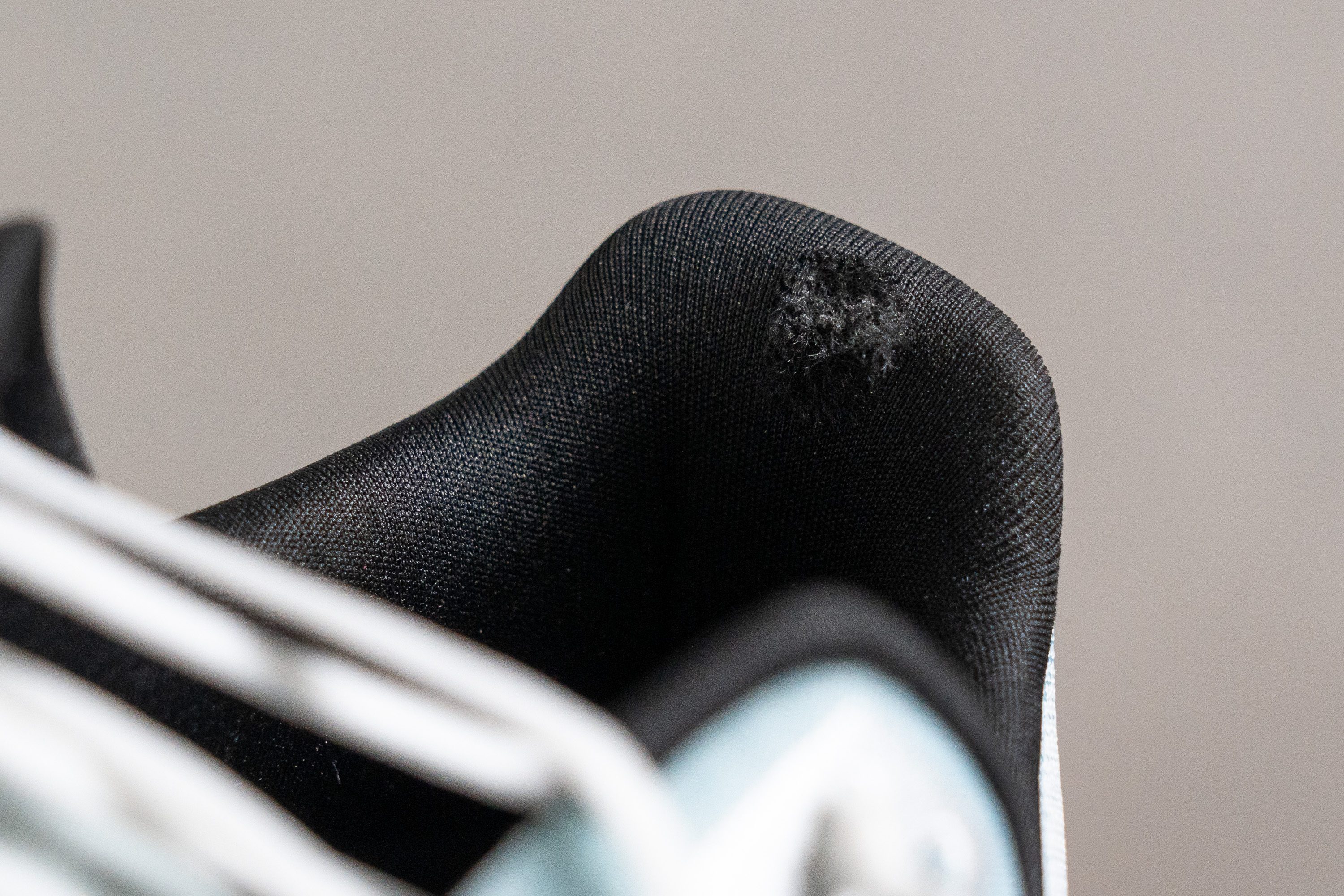
| Cloudtilt | 1 |
| Average | 2.3 |
Outsole hardness
There is no full-length outsole on the Cloudtilt but it uses a fairly hard compound in the most critical areas (forefoot and heel).
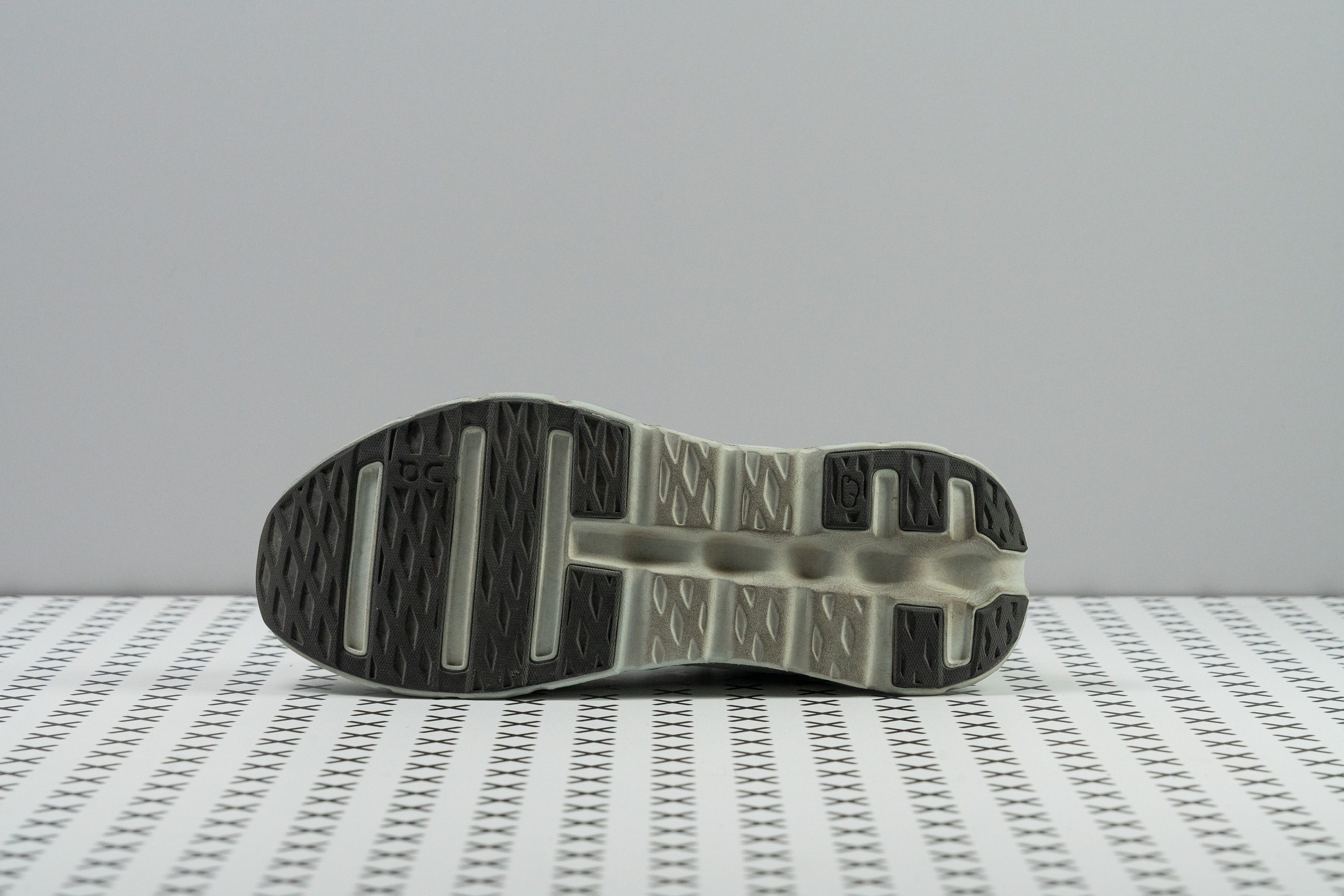
Pressing a Shore C durometer against the shoe's rubberized areas, we got a reading of 81.6 HC. This is 7% harder than the average we've measured among walking shoes.

| Cloudtilt | 81.6 HC |
| Average | 78.0 HC |
Outsole durability
To make sure that rubber is not only hard but also abrasion-resistant, we challenged it to a 22-second drilling test at a 10K RPM speed.
And the compound proved to be steadfast! We could barely even see the damage from the sandpaper. Considering that our tread gauge measured as little as 0.6 mm of damage, this is not surprising!
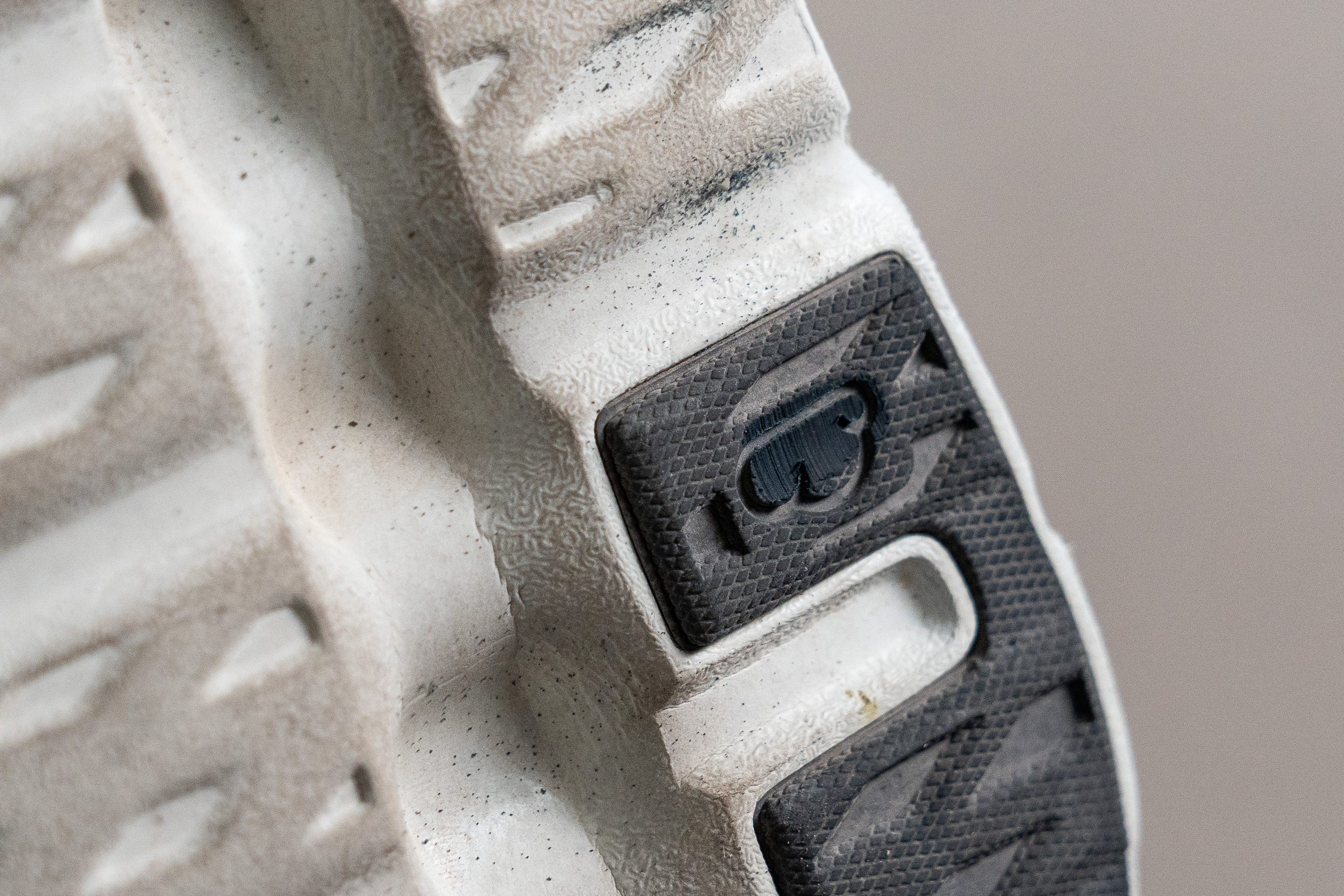
| Cloudtilt | 0.6 mm |
| Average | 1.4 mm |
Outsole thickness
It was also reassuring to find that the rubber layer is fairly thick on the Cloudtilt. According to our caliper, it comes in at 3.1 mm.
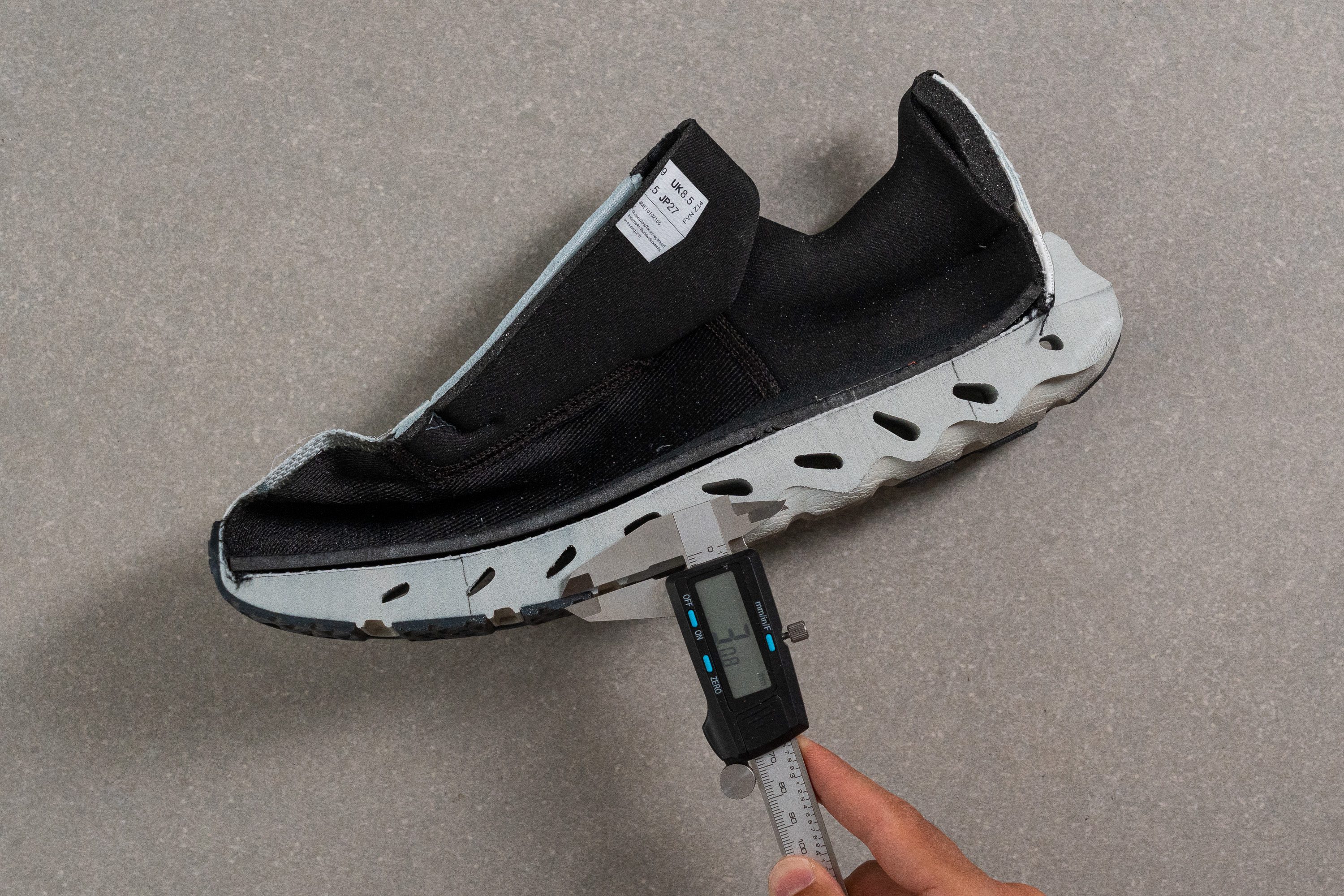
Even though exposed foam makes this On shoe more prone to abrasion, we believe that it is duly protected in the high-wear areas.
| Cloudtilt | 3.1 mm |
| Average | 3.0 mm |
Misc
Insole thickness
Inspecting the shoe's insole, we once again felt as though the brand saved some money on the interior materials.
The footbed was notably thinner than average and felt like cardboard!
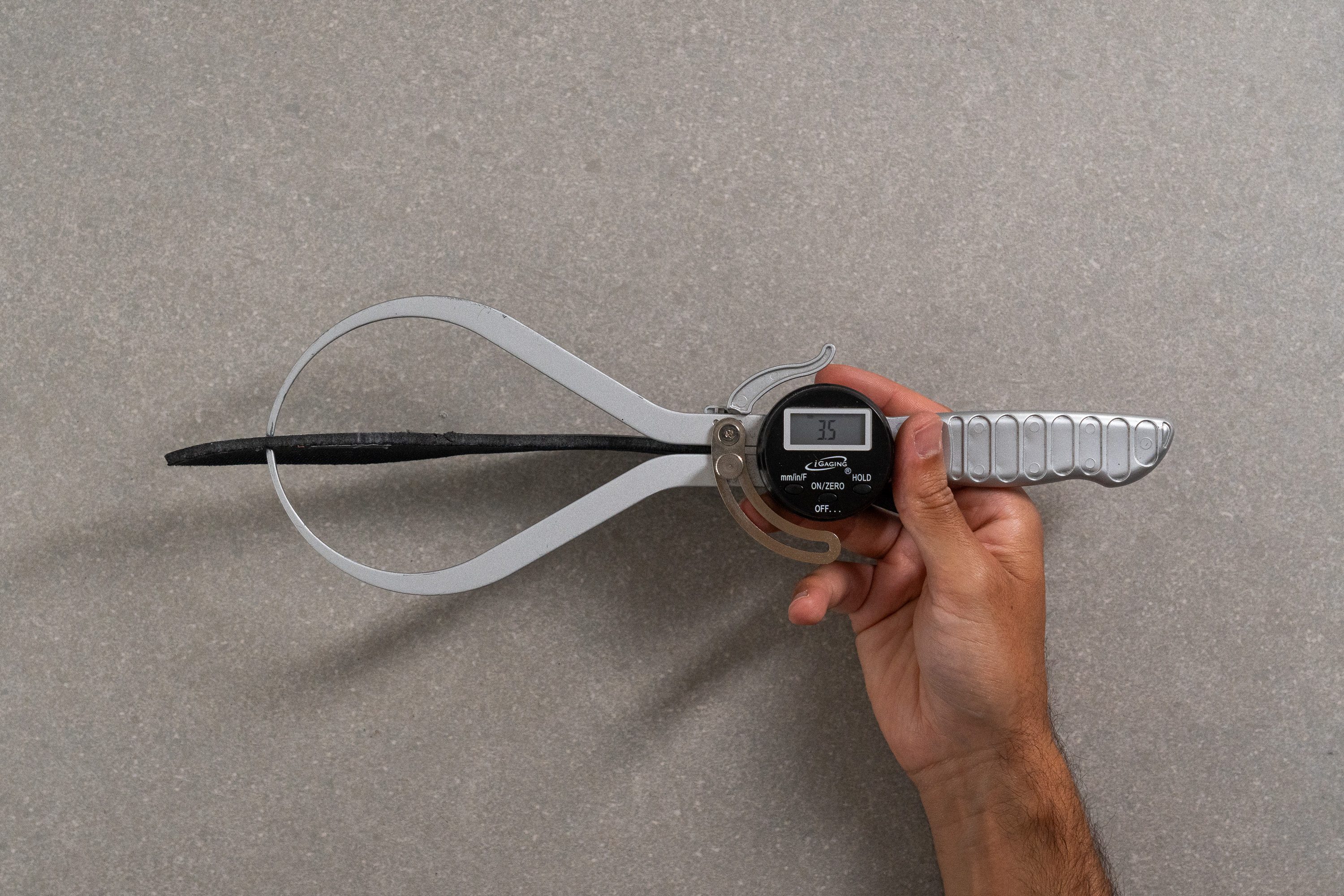
Our caliper recorded only 3.5 mm of insole thickness whereas most walking shoes have at least 5-6 mm! Perhaps all of the brand's fancy tech went into the shoe's midsole...
| Cloudtilt | 3.5 mm |
| Average | 5.8 mm |
Removable insole
If, like us, you are not happy with the shoe's standard insole, you can easily swap it.
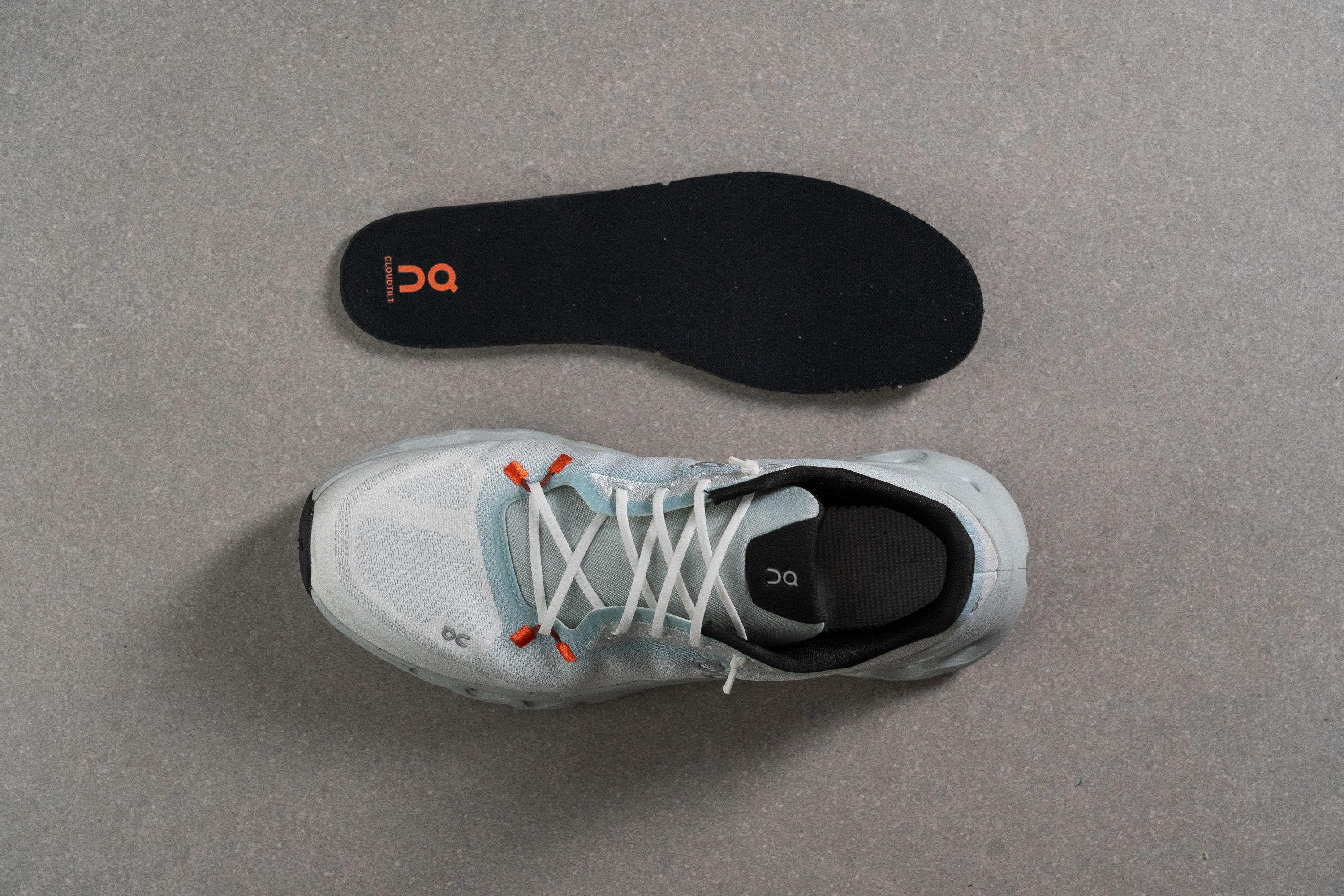
| Cloudtilt | Yes |
Midsole softness in cold (%)
But if you are considering the Cloudtilt for the cooler season, be prepared for a moderate loss of midsole softness.
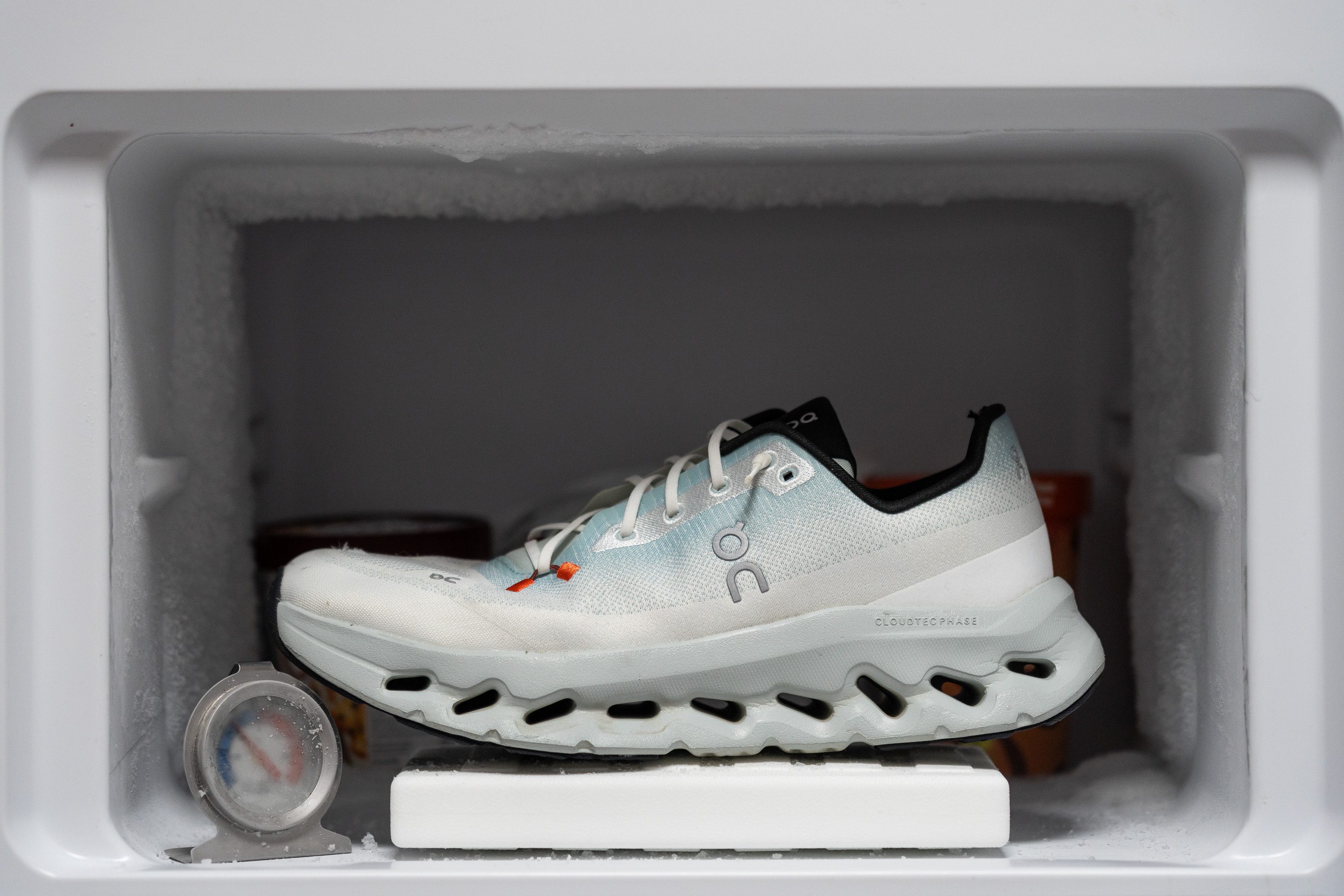
Having exposed the shoe to low temperatures for 20 minutes, we found that its foam firmed up by 33.7%. But this is a normal change in softness for walking shoes.
| Cloudtilt | 34% |
| Average | 30% |
Reflective elements
On made sure that others see you wearing their product even in the dark - all the On logos are made of reflective material.
| Cloudtilt | Yes |
Tongue padding
The tongue of the On Cloudtilt is sufficiently padded at 5.4 mm. This is a normal amount of tongue foam across walking shoes.
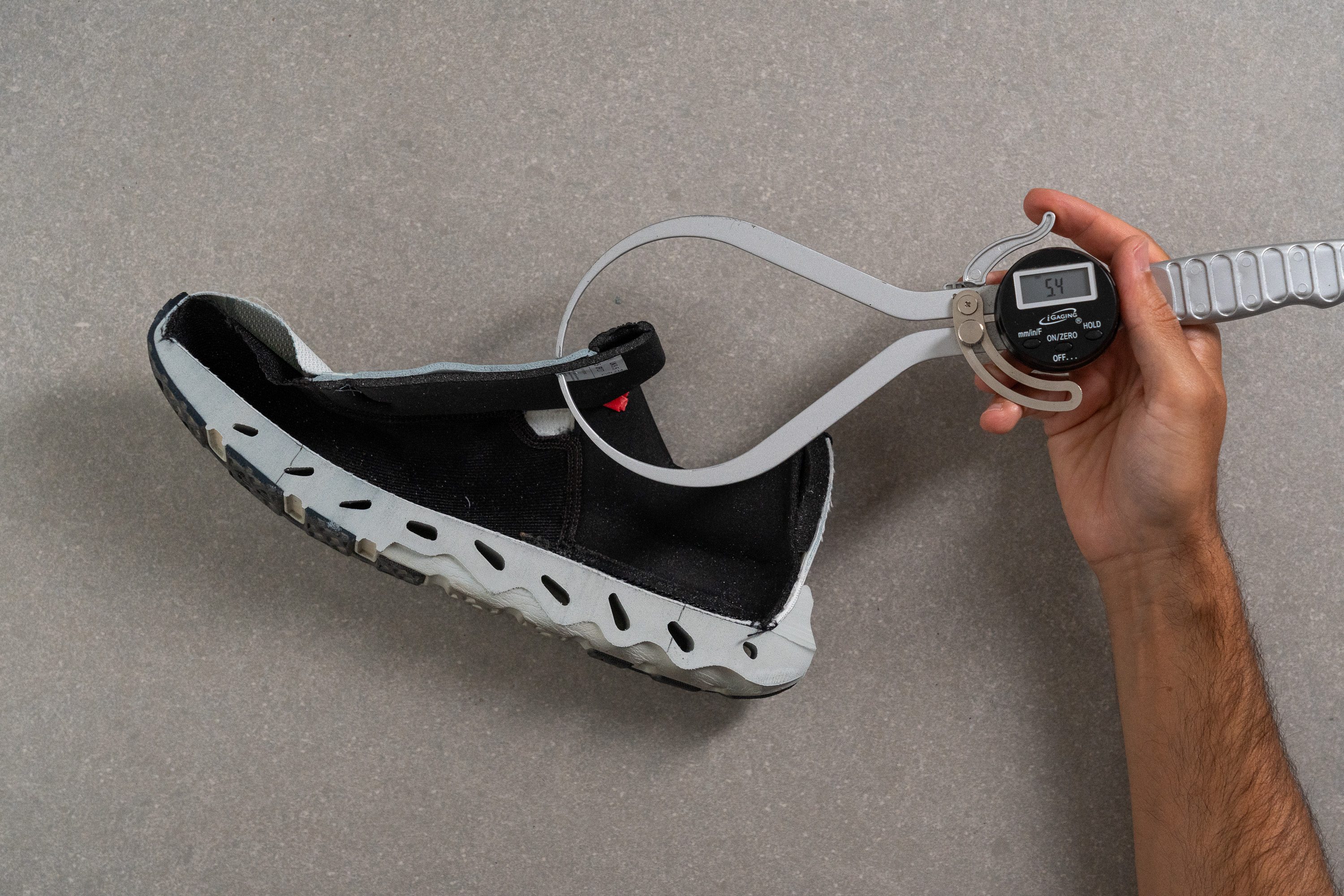
| Cloudtilt | 5.4 mm |
| Average | 5.6 mm |
Tongue: gusset type
The shoe's midfoot fit is enhanced by a semi-gusseted tongue. We are glad to see this feature on the Cloudtilt as it creates a more secure foothold and prevents the tongue from shifting on the move.
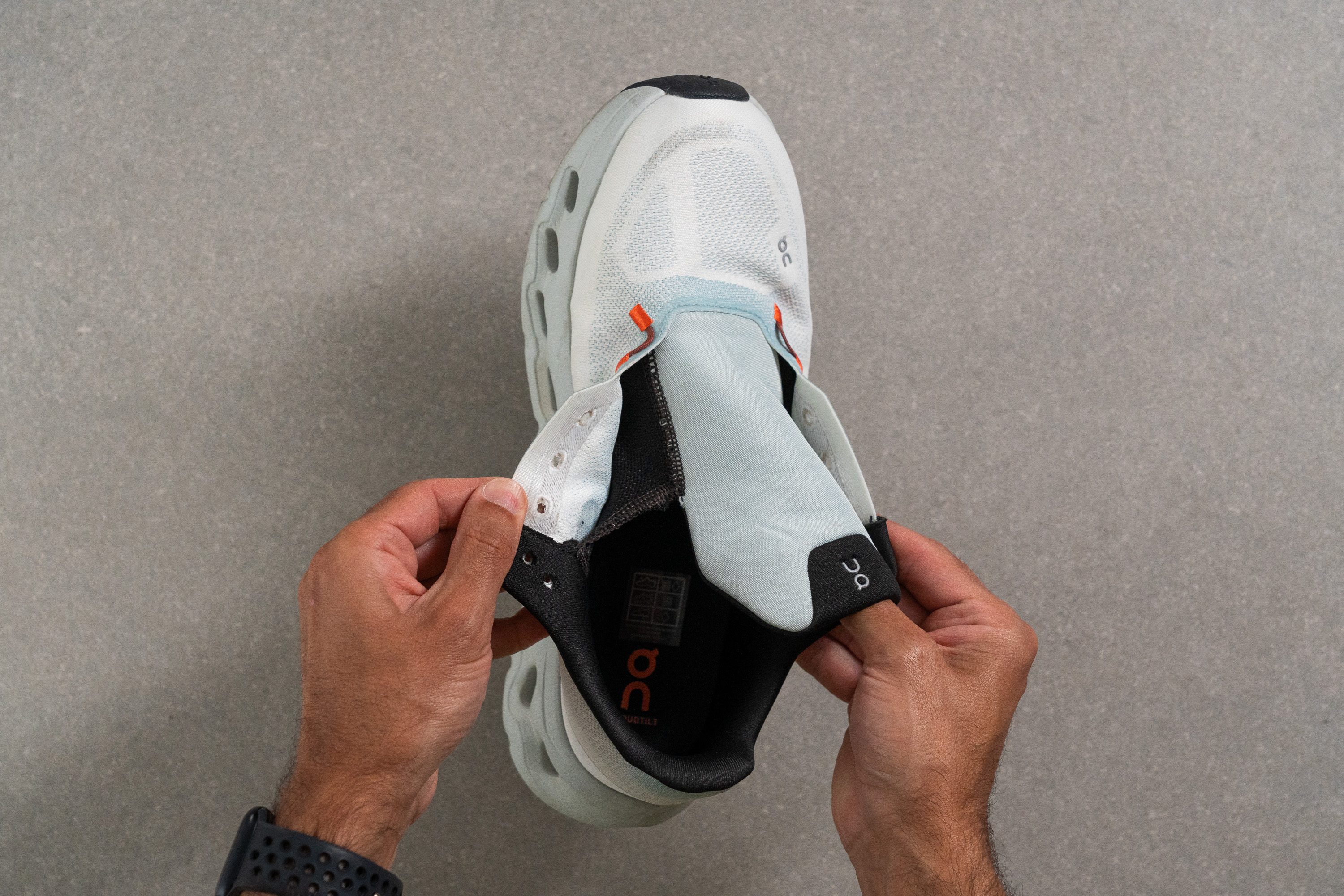
| Cloudtilt | Both sides (semi) |
Heel tab
There are no finger loops on the Cloudtilt but its bungee lacing allows for a pretty easy on-and-off.
| Cloudtilt | None |
Sustainable materials
Unfortunately, we cannot test the sustainability of materials in our lab (yet). For now, we have to trust On when it claims that 100% of the Cloudtilt's upper is made of recycled polyester.
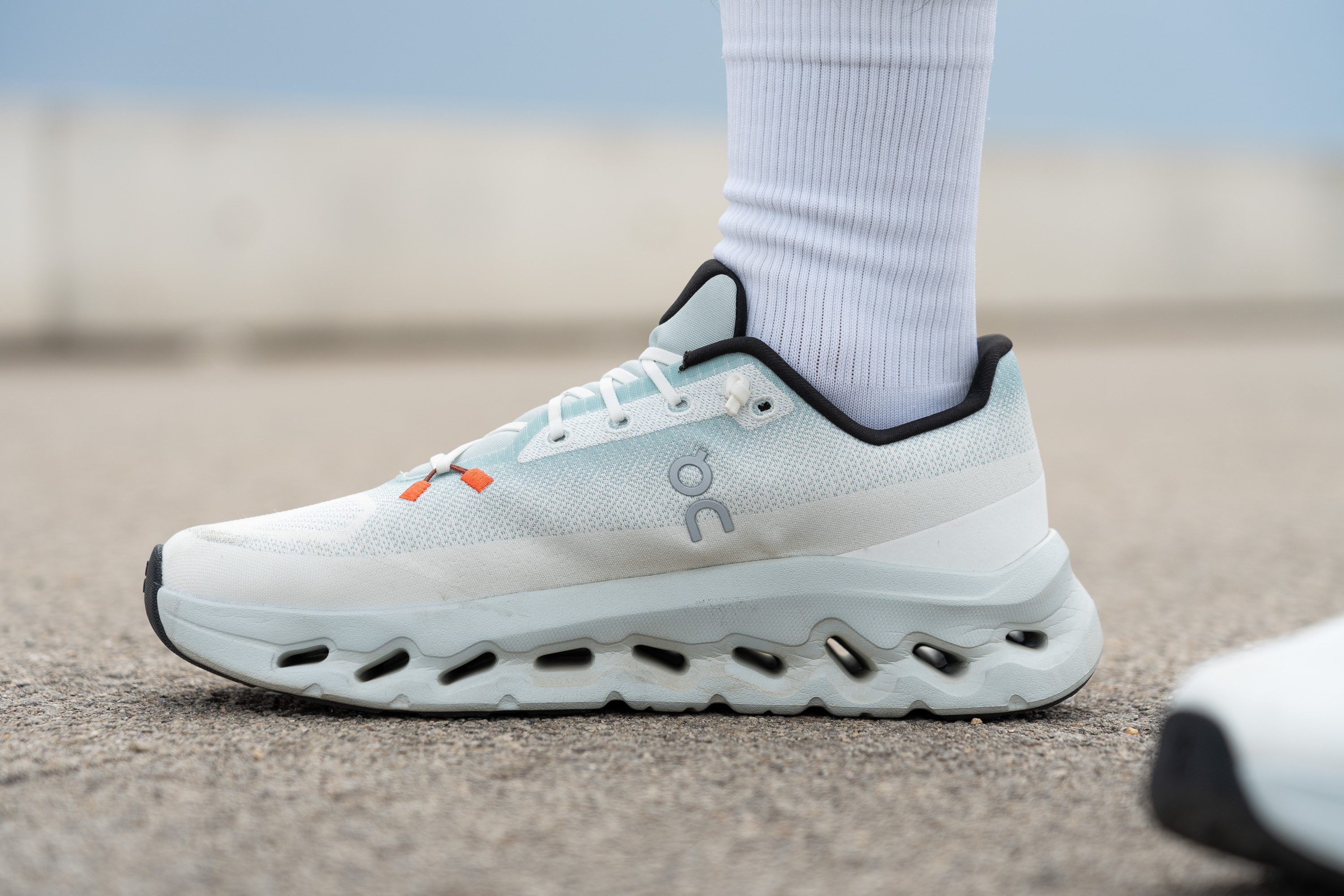
The brand also claims that the shoe is dope dyed - a process that uses 90% less water than the standard dying method.



























































